|
|
CP Motive Power News |
In late-May, the following CN locomotive models were repaying Horse Power hours to CP: One SD70I, and five SD75I’s which were used system wide. Two of them were used together in transfer service in Winnipeg, MB, CN 5766 was seen on the CP in Buffalo, NY, and another was a trailing power on a CP Ethanol train passing through Montreal heading down the D&H the last week of May.
CP GP38-2 3084 was released from NRE May 1st in full CPR script, and was repainted using the original formula for the grey… and it is perfect! It arrived in Toronto in mid-May, and on May 12th, it was in transit to Calgary, AB. On may 18th she was operating between Edmonton, and Calgary, AB. NRE took the liberty of making the number boards a little more legible, and the cab number and name on sides were actually ‘hand’ painted from drawings for the GP-35’s! As a heritage paint schemes go this is exceptional. CRO salutes Nation Railway Equipment - Slivis and the Canadian Pacific Railway for a job well done! (Photos courtesy NRE)
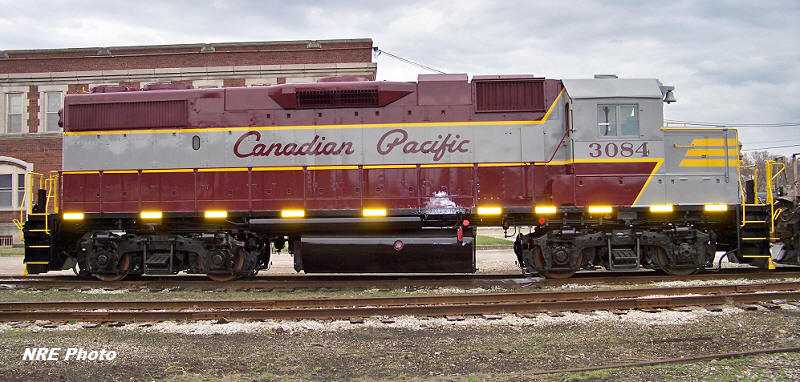
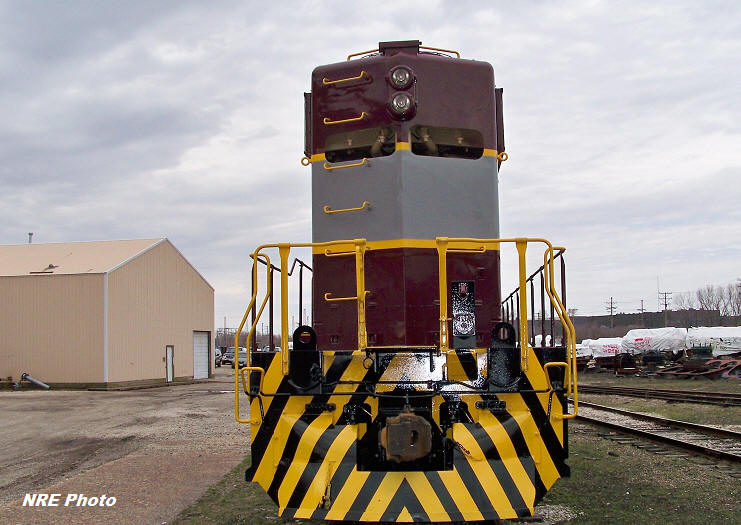
On March 8th, Jay Butler caught CP 3084 trailing on CP 240 as she passed eastbound through Tilsbury, ON.
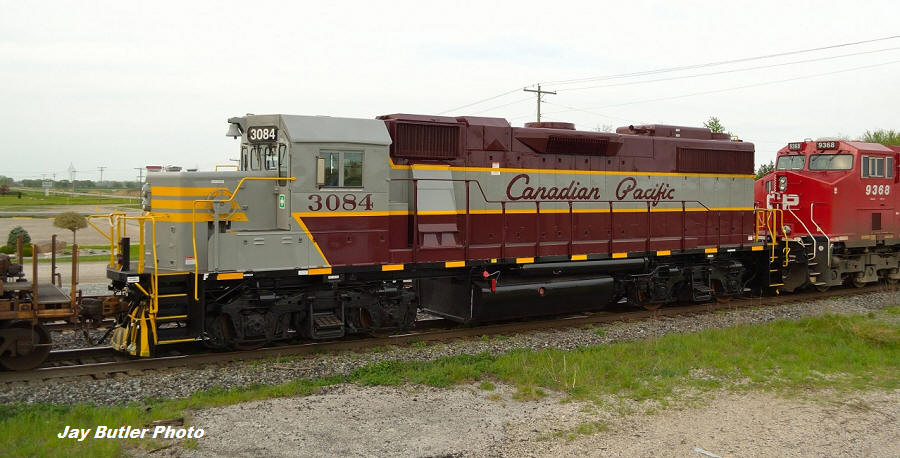
Kenneth Borg caught CP #240 eastbound at Delray Interlocking in Detroit, MI on Thursday, May 09, 2013. CP 8870, 9368, 3084.
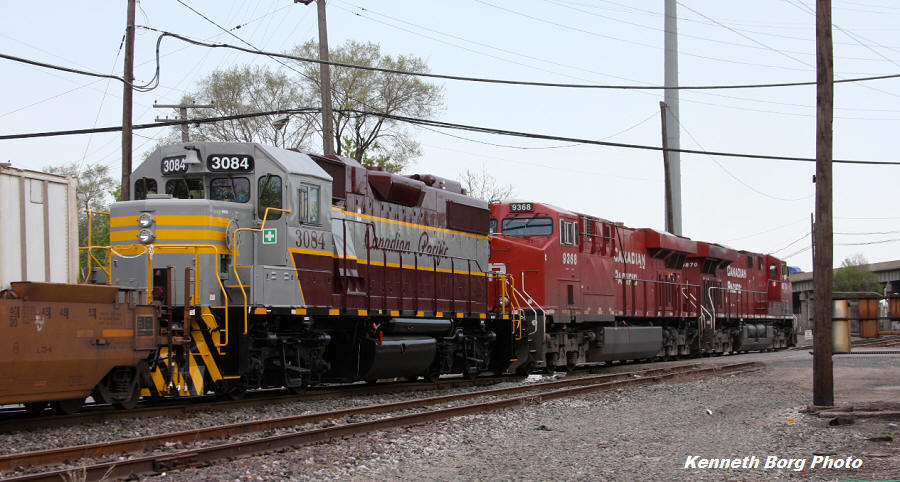
CPR 1900 was repainted into “SCRIPT Lettering.
The big news in May was that CP F9B 1900 had been repainted into the CPR “Script” lettering following her mini overhaul at NRE in April. Updating the block lettering to script was a wise decision by Canadian Pacific, as the B-unit can now aesthetically match up with the CPR script liveried GP28-2 / FP9Au duo. As was done with GP38-2 3084, CP 1900’s numbers and lettering was carefully applied by hand, with the grey and Tuscan Red matched from paint samples provided by CP. At press time, she was not yet released, and no company photographs had surfaced. She is expected to be released in early June.
Seen here in her previous 1950's heritage block lettering paint scheme, CPR F9B 1900 has now been repainted into Canadian Pacific Railways 1960's "Script" livery at National Railway Equipment (NRE) in Silvis, Illinois.
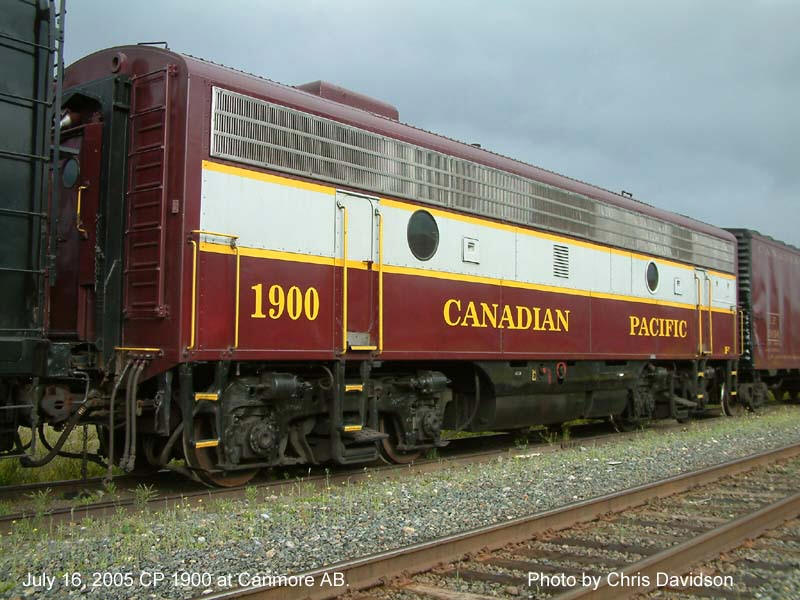
Now that CP GP38-2 3084 and F9B 1900 are now freshly painted, it is rumored they are to be assigned to the CP business train which soon have the three recently acquired ex-CN business cars being repainted CP. In late April, former Wisconsin Central heavy weight rear platform observation car “Superior” had been relettered to CP 3 at the CN Woodcrest Shop still wearing the WC maroon and yellow paint scheme. One month earlier, CP acquired Track inspection theater car CN 1060 “Sanford Fleming” ( now “CP1”), and CN heavyweight platform observation car 1058 (now “CP2”) currently at Quality Rail in East St. Louis, IL for repaint in CP livery.
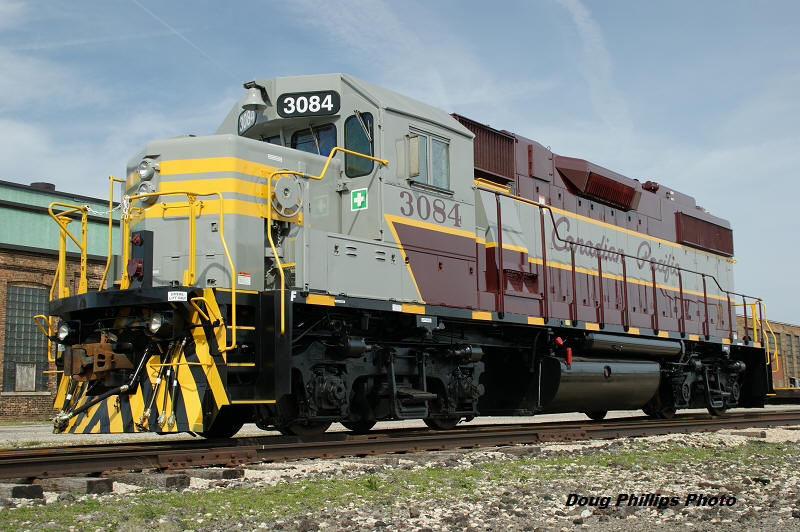
CP Units Retired (or Sold) Recap
CP GP40-2 4654 and 4655 were retired in August 2012,and sold in January 2013, and are now at Metro East Industries East St. Louis, IL. Wearing fresh paint, United States Sugar Corporation (USSC) GP40-2 503 (ex-CP 4654, nee-B&M 315) sold to MEI in the winter of 2012 was shopped and resold to USSC as 503 taken on MEI property with both MEI and USSC permission. United States Sugar Corp has also bought ex-CP GP40-2 4655 which is currently at MEI getting overhaul and USSC paint. We will obtain her photo next month.


Another former CP geep is also at Metro East Industries East St. Louis, IL, SOO GP40 2041 was retired in November 2012, sold in March 2013.
In January 2013, retired SW1200RS 1237, 1250, and 1251 were sold to NRE - Silvis, IL and SW1200RS 1239 and 1241 were sold to Independent Diesel services in Thief River Falls, MN.
As well, CP GP7u 1509, CP GP9u 1599, 1626, 1630, and 1694, CP Slugs 1127 and 1128 were retired in Winnipeg, and sent to Moose Jaw, SK. for scrapping. The pair had mated to GP38-2 (Mother’s) 3027 and 3028. CP 3027 is currently at CAD-Lachine QC for overhaul.
All the remaining SD9043MAC units on the roster, CP 9100-9128, 9130-9132, 9134-9137, and 9139-9160, were sold in April 2013. However, the buyer is not known, and remain in storage in Winnipeg, MB.
|
CP LOCOMOTIVE REBUILD PROGRAMS |
CP units stored in May 2013:
Due to a Spring downturn in traffic, CP has stored one hundred units system-wide including SD40-2’s, ES44ACs, Ac4400CW’s, and SOO GP38-2 4407* (which is Stored Unserviceable). Some of the CP AC4400CW’s stored include: CP 8533, 8561, 8613, 8628, 8645. 9536, 9537, 9539, 9540, 9544, 9545, 9555, 9559, 9562, 9564, 9567, 9573, 9574, 9579, 9582, 9586, 9616, 9654, 9674, 9700, 9708, 9711, 9713* (Stored Unserviceable after a third person crossing accident in Tilly, AB), 9719, 9724, 9733, 9757, 9774, 9781, 9784, 9801, 9802 and 9810.
Some of the CP AC4400CW’s earmarked for CAD for work over the next few month include: CP 8520, 8624, 8639, 9517, 9521, 9523, 9524, 9527. 9554, 9556, 9558, 9560, 9622, 9649, 9751, 9735, 9803, 9810, 9822, 9825, and 9831. Released from CAD during May were CP 9725, 9750, 9751 and 9772.
CP GP38-2 Overhaul Update:
The overhaul of GP38-2’s for Tier 0+ compliance, equipping them with AESS (Locomotive Automatic Engine Start/Stop), and repainting them into CP livery spread over two facilities: EMD-Progress Rail and at National Railway Equipment. However, in recent month CP is only contracting NRE to complete the SOO and CP GP38-2 overhauls. As well, the CP GP38AC and D&H GP38-2 fleets are also earmarked for overhaul only at NRE.
GP38-2’s released from CAD Railway Services Lachine, QC:
CP 3027 was released in mid-May after major repairs. She retains her old CP beaver livery, and did get an overhaul.
GP38-2's released from EMD-Progress Rail (Mayfield, KY):
CP 3024, 3025, 3038, 3040, 3041, 3042, 3048, 3057, 3061, 3062, 3066, 3111, 3117, 3126, 3127, 3128, 3129, 3133, and (former SOO) CP 4414, 4415, 4418, 4424, 4427, 4428, 4436, 4446, 4447, 4450, 4506, 4513, 4514, and 4515 completing the contract. No more CP GP38-2's scheduled for overhaul at EMD-Progress Rail (Mayfield, KY)
GP38-2’s released from NRE (Silvis, IL):
CP 3007, 3033, 3075, 3084 (CPR Script), 3103, 3124, 3134, CP 4426 (Former Soo Line). As well, CP F9B 1900 was released in May fully repainted in CPR. Script livery. In April the first former CP GP38AC was released as CP GP38-2 3007 and was reassigned from Coquitlam, BC, to Moose Jaw. SK. As well, NRE-rebuild CP 4426 a former SOO GP38-2 was reassigned from St. Paul, MN to Alyth, AB.
GP38AC's & GP38-2's to be overhauled at NRE (Silvis, IL):
CP GP38AC 3001, 3013, 3017, CP GP38-2 3023, 2050, 3070, STLH (ex-D&H) 7308, SOO 4400 (wreck damage), 4439, and SOO 4449, were all at various stages of overhaul in early May.
Earmarked for overhaul at EMD-Progress Rail in Mayfield, KY, are CP GP38-2 7307 and D&H 7304 which in early May were still assigned to locals in the Windsor, ON and Dearborn, MI area. Jay Butler bagged T76 with his cellphone camera, just east of Haycroft, ON, May 8th. All nine ex-D&H GP38-2’s are earmarked for overhaul and repaint at NRE.
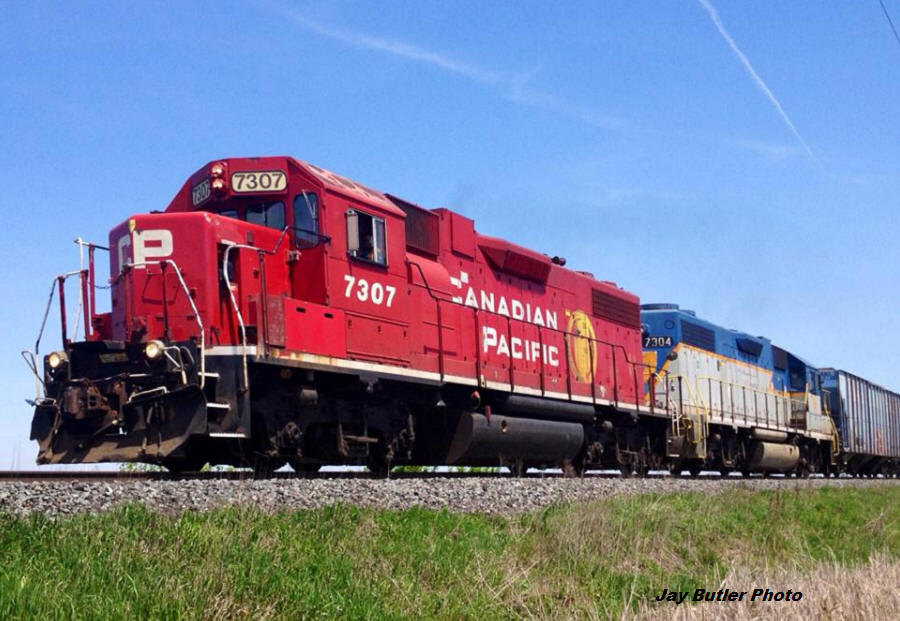
Jay also bagged former D&H GP38-2’s CP 7309 and CPRS 7310 on T76 clearing the mainline at Tilbury, ON March 8th. In mid-March, CP 7309 and CPRS 7310 departed Windsor, and will soon be sent to NRE for overhaul and a CP repaint.

Steve Koenig snapped D&H 7304 heading north into Canada on CP 255 April 17th. She is now working in Windsor Ontario on locals, and is earmarked for overhaul and repaint at NRE in Silvis, IL. D&H painted 7303 and 7312 and all the Candy Apple Red painted ex-D&H GP38-2’s in the CP 7300 series, are also to be sent to NRE as space opens up.


Released from CAD after repairs, CP 3027 did not receive an overhaul and repaint as was believed, and does not appear to have had any exterior work done. Richard Marchi photographed her at St-Luc Diesel Shop April 28th the two days after she departed the Lachine locomotive facility, and as of May 13th, was still in Montreal.
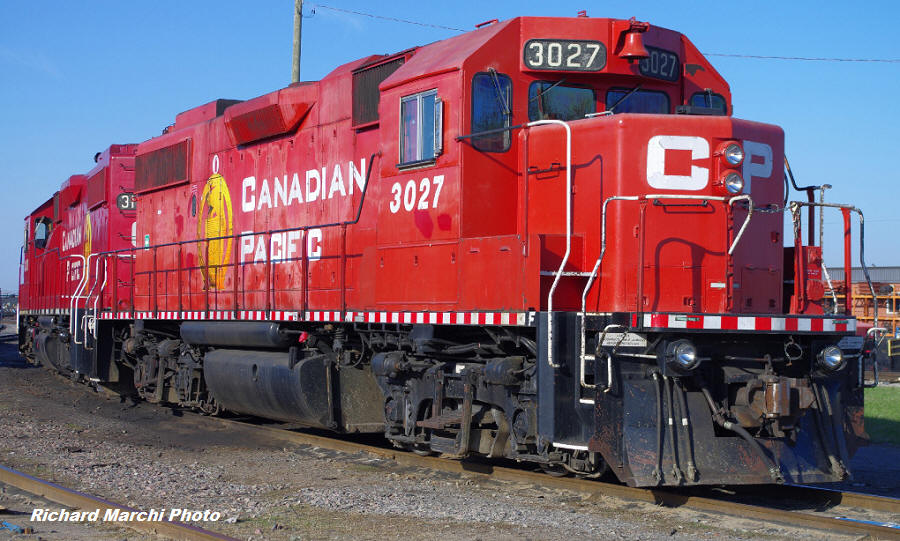
|
SOO SD60 Overhaul Update: |
SOO SD60 overhaul update:
CAD Railway Services (Lachine, QC) is contracted to overhaul the remaining fleet of SOO SD60’s and four SD60M’s to Tier 0+ compliance, equip them with AESS (Locomotive Automatic Engine Start/Stop) to conserve fuel, and repaint and renumber to CP 6200-series. The entire rebuilt SD60 fleet will receive (PTC) Positive Train Control modifications at the CP St-Luc Diesel Shop.
In Service:
CP SD60M 6262 (ex-SOO 6062) was released April 29th, 2013
CP SD60 6239 (ex-SOO 6039) was released April 29th, 2013
CP SD60M 6259 (ex-SOO 6059) was released in April 2013
CP SD60M 6259 (ex-SOO 6058) was released in April 2013
CP SD60 6231 (ex-SOO 6031) released January 20th, 2013
CP SD60 6249 (ex-SOO 6049) released December 21st , 2012
CP SD60 6238 (ex-SOO 6038) released December 4th, 2012
CP SD60 6256 (ex-SOO 6056) released November 29, 2012
CP SD60 6246 (ex-SOO 6046) released November 20, 2012.
CP SD60 6230 (ex-SOO 6030) released November 1st, 2012
CP SD60 6236 (ex-SOO 6036) released October 26th, 2012
CP SD60 6221 (ex-SOO 6021) released October 6th, 2012.
CP SD60 6223 (ex-SOO 6023) released September 20th, 2012
CP SD60 6257 (ex-SOO 6057) released August 31st. 2012
CP SD60 6234 (ex-SOO 6034) released August 15th, 2012
CP SD60 6252 (ex-SOO 6052) released July 25th, 2012
CP SD60 6255 (ex-SOO 6055) released June 21st, 2012
CP SD60 6229 (ex-SOO 6029) released June 5th, 2012
CP SD60 6243 (ex-SOO 6043) released April 20th 2012
CP SD60 6254 (ex-SOO 6054) released March 29th 2012
CP SD60 6245 (ex-SOO 6045) released March 6th 2012
CP SD60 6242 (ex-SOO 6042) released March 1st 2012
CP SD60M 6260 (ex-SOO 6060) released January 13th 2012
CP SD60 6228 (ex-SOO 6028) released December 16th 2011
CP SD60 6225 (ex-SOO 6025) released December 1st 2011
CP SD60 6241 (ex-SOO 6041) released November 2011
CP SD60 6240 (ex-SOO 6040) released October 2011
CP SD60 6250 (ex-SOO 6050) released October 2011
At Cadrail:
SOO SD60 6047 arrived in Montreal January 17th
SOO SD60 6048 arrived in Montreal January 17th
SOO SD60 6022 arrived in Montreal April 26th
SOO SD60 6051 arrived in Montreal in April 19th
On May 12th, CP SD60M 6262 shows off her new Candy Apple Red uniform at St-Luc Diesel Shop with SOO 6032 behind.
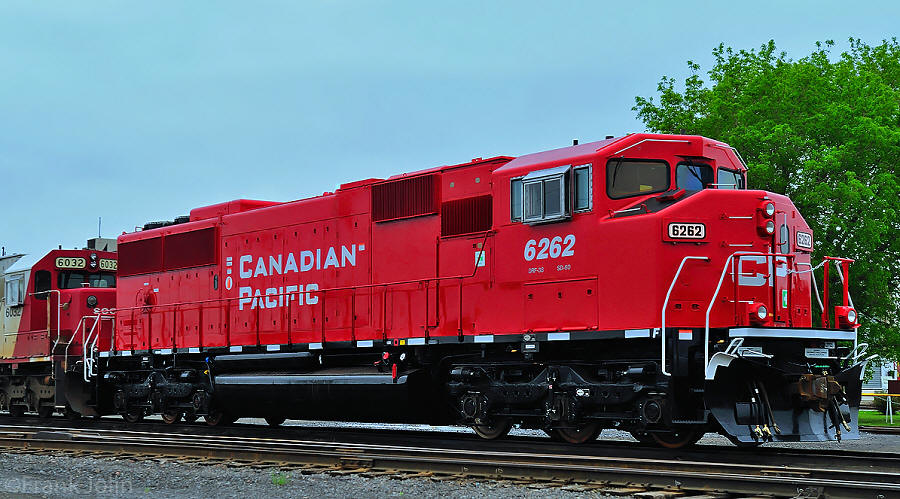
Bob Heathorn missed CP SD60M 6259 on her maiden trip through Smiths Falls on April 16th, but in early May, the former SOO widecab was seen frequently in the area assigned to a railtrain delivering CWR on the Belleville sub.
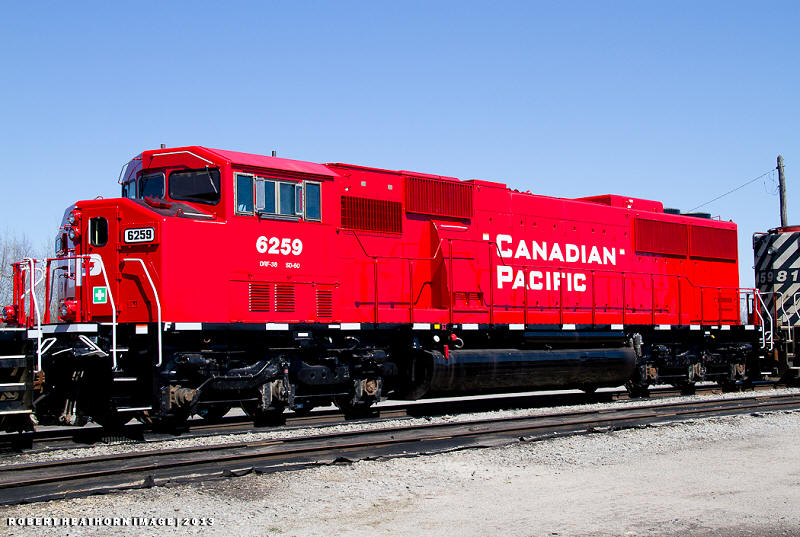
Eric Salter has listed the last SD60’s remaining in SOO LINE paint and their last traced locations as of mid May:
Running:
SOO6048 arrived St.Jean, QC 3/20/13 Leased to MMA
Not Running:
SOO6022 arrived St.Luc 4/27/13 was moved to CAD in May.
SOO6024 on 242-10 moving toward CAD by Elkhart, IN 1114-10
SOO6026 at St.Luc 4/19/13
SOO6027 at Toronto Yard since 1/8/13
SOO6032 at St.Luc 5/3/13
SOO6033 on 242-10 moving toward CAD by Elkhart, IN 1114-10
SOO6035 at Toronto Yard since 1/8/13
SOO6037 on 286-09 moving toward CAD by Milwaukee, WI 1312-10
SOO6044 at Toronto Yard since 1/8/13
SOO6053 on 242-10 moving toward CAD by Elkhart, IN 1114-10
SOO6061 on 242-10 moving toward CAD by Elkhart, IN 1114-10
SOO6062 at St.Luc 1/11/13
|
CP SD30C-ECO Update: |
A large group of CP SD40-2’s are getting rebuilt at EMD-Progress shops to meet Tier 0+ US emissions standards are in Mayfield, Kentucky. CRO has learned the order is behind schedule and will not be completed until late this year. Assigned the CP 5000-series the SD30C-ECOs are rebuilt from SD40-2 cores and frames, and powered by a new 12 cylinder 3000 hp 12-710G3F engine. In late-May, CP 5000-5009 had been entered into the CP computer database. It is believed they will be assigned to St. Paul. MN. These are very late, and CP has been compensated by EMD for this.
Further information about ECO re-powering can be found here:
http://www.progressrail.com/repowered-locomotives-710ECO.asp
At Mayfield, KY April 18th, Lon Coone shot, CP 5006 and 5007 near the plant.

CP 5001: http://www.rrpicturearchives.net/showPicture.aspx?id=3482059
CP 5007: http://www.rrpicturearchives.net/showPicture.aspx?id=3482060
CP 5005: http://www.rrpicturearchives.net/showPicture.aspx?id=3482061
CP 5003: http://www.rrpicturearchives.net/showPicture.aspx?id=3482062
The following 20 CP SD40-2's are to be done over the next 12 months: 5415, 5672, 5691, 5728, 5734, 5735, 5745, 5789, 5869, 5918, 5933, 5934, 5950, 5971, 5980, 5983, 6027, 6039, 6056 and 6606.
The following SD40-2's and SD40-2F's are earmarked for ECO rebuild beginning in late 2013: SD40-2’s 5648, 5787, 5795, 5844, 5902, 5924, 5930, 5931, 5940, 5944, 5947, 5948, 5967, 5992, 5997, 5998, and 6006, and SD40-2F’s: 9000, 9002, 9005, 9010, 9016, 9018, 9022, and 9024.
Brand new CP 5000 and 5007 are seen at Mayfield. KY in late-April.
http://www.canadianrailwayobservations.com/CPSD30Cunit1.jpg
http://www.canadianrailwayobservations.com/CPSD30Cunit1.jpg
|
CP GP20C-ECO Update: |
With the exception of CP 2219, all 30 GP20C-ECO units (nos. 2200 -2229) from their first order from EMD’s Muncie, IN plant had been delivered, and were in service assigned to St-Paul, MN.
However the big news in May had CP 2200 and 2212 reassigned from (SOO territory) St. Paul, Minnesota, to CP in Medicine Hat, Alberta. This is the last CP crew change location before Calgary, AB, and these are the first two GP20ECO’s to operate in local service in Canada.
Here are the CP 2200-series arrival dates on the property:
(Compiled by Bruce Chapman and Ken Perry)
CP 2210, 2211, 2212, 2213, 2214 and 2215 arrived on CP 01/01/13
2. CP 2200, 2201, 2202, 2205, 2206, 2207, 2208 and 2209 arrived on CP 01-09/13.
3. CP 2203, 2204, 2216, 2217, 2218, 2220, 2221 and 2222 arrived CP 01/11/13.
4. CP 2223 2224 2227 2228 delivered 3/7/13
5. 2225 2226 2229 delivered 3/25/13.
Note: CP 2229 subsequently failed and was TUUS on March 29th.
6. CP 2228 suffered severe collision damage on the Soo Line, and was sent to NRE Silvis for major repairs in mid-April.
UMLER CP GP20C-ECO Numbering: CP 2200 as ex-1528, 2201 ex-1568, 2202 ex-1501, CP 2203 as ex-1525. 2204 ex-1567, 2205 ex-1697, 2206 ex-1515, 2207 ex-1581, 2208, ex-1638, 2209 ex-8240, 2210 ex-1566, 2211 ex-1603, 2212 ex-1682, 2213 ex-1505, 2214 ex-1696, 2215 ex-1611, 2216 ex-1565, 2217 ex-1617, 2218 ex-1503, 2219 ex-8229, 2220 ex-1588, 2221 ex-1644, 2222, ex-1570, 2223 ex-1569, 2224 ex-8264, 2225 ex-1621, 2226 ex-1519, 2227 ex-1612 2228 ex-1615, and CP 2229 shows as ex-1639.
CP have now earmarked 61 more that are destined to Port Coquitlam over the next
year, or more including many GP9u’s still in service now. One surprise in March
was that ICE GP9 103, 105, 114 are to be moved to Coquitlam, BC for the program,
stripped and scrapped.
These GP7u/GP9u loco’s are retired and tied up and will pass through Coquitlam, BC pending cannibalization for usable components at the SRY shops in New Westminster, BC, Later on these will be scrapped at ABC Metals in Langly, BC.
Noted at the CP Coquitlam Diesel Shop on April
19th were:
1. Fast Track: CP 1639, 1508, 1615, 1557, 8227, 8230, 1614, 1538, 1609,
1647, 1636, 1632, 1692, 1575, 1599, 1626, 1687, 1694.
2. DS3W: CP 1509
3. DSF2: CP 1607, 1610, 1573, 1574, 1514, 8237, 1543, 1020, 1010, 1628,
1546, 8214, 1630.
At press time the last group that had been sent to SRY for stripping were
CP 1530, 1599, 1612, 1618, 1626, 1652, 1687, 1691, and 1694. Once cannibalized,
they will be moved from New Westminster, BC, for scrapping at ABC Metals.
The following GP7u/GP9u locos have already been scrapped at ABC Metals.
CP 1501, 1503, 1505, 1515, 1519, 1525, 1528, 1565, 1566, 1567, 1568, 1569, 1570, 1581, 1687, 1588,1603, 1611, 1617, 1621, 1638, 1644, 1649, 1682, 1687, 1692, 1696, 1697, 8224, 8229, 8240, 8242, and 8264.
|
CP Leased Locomotives on the property in May |
CEFX (AC4400CW) IN SERVICE: 1002, 1006, 1007, 1014, 1018-1020, 1023, 1024, 1026-1059. In May, CEFX 1023 and 1041 were Tied Up Serviceable. (All SOO-owned on paper as of February 28th 2011).
CITX (SD40-2) TIED UP (Stored Serviceable): 2783 2785 2790 2792 2794 2796 3008 3024 3026 3035 3036 3053 3054 3055 3056 3057 3058 3059 3060 3061 3062 3063 3064 3065 3067 3070 3071 3073 3078 3080 3083 3086 3087 3090 3091 3092 3095 3098 3099 3100 3101
CEFX (SD40-2) TIED UP (Stored Serviceable): 2786 2791 2797 2802 2803 3105 3112 3117 3121 3130 3163 3164 3166 3168 3172 3173 3176 3181 3182 3184 3188
In July, CITX 3032 was removed from storage at Coquitlam, BC and sent to the SRY for lease and there are some others leased to MMA. Currently undergoing repair at CAD are CITX (CEFX) SD40-2 3071, 3082, 3101, 3172 and 3155.
|
CP Photos |
At Westport, NY on May 7th, Canadian Pacific Railway's geometry train (TEC-07), has pulled down behind a southbound oil train on the Howards Siding moments after the crew experienced a near-catastrophic encounter with a heat kink. The train with SD40-2 6069, had been on the approach to Howards at inspection speed and encountered the heat kink, wobbling the entire train through before getting it stopped - thankfully keeping it all on the rails, despite initial thoughts that it had derailed.

Nick Smith, photographed ICE 6429 and 6212 on CP's B91 transfer, seen under the famous Western Auto sign, holding at Union Station waiting for the signal and return to Liberty, MO. These two engines have just come from UP's Armourdale Yard where they dropped off a cut of auto racks August 6th, 2012.
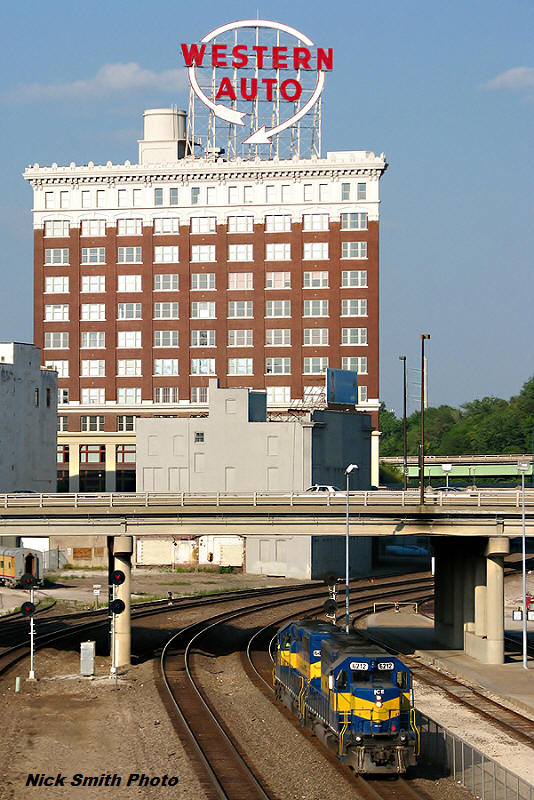
On May 2nd, Geoff Elliot caught CP SD40-2 5935, SD60 6236, and another SD40-2 leading train 641-041 at Elmstead, ON.
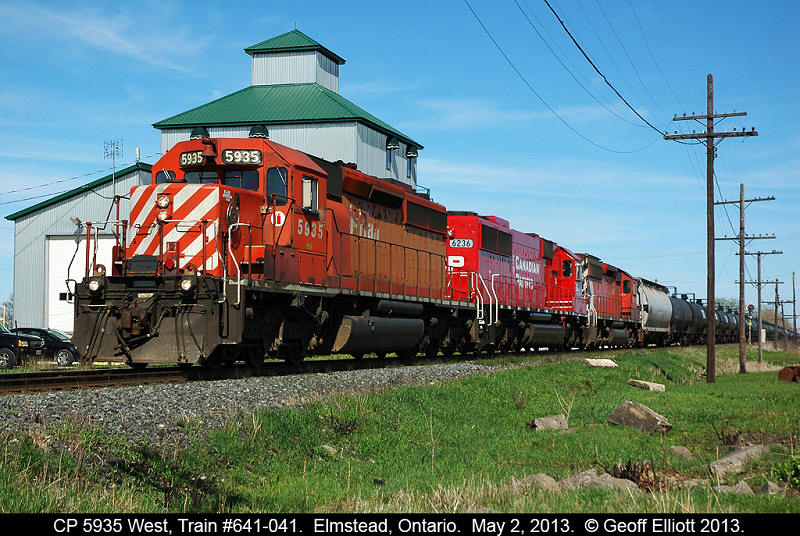
On the same day, GP38-2’s D&H 7304 and CP 7307 were in charge of Windsor local T76. PHOTO
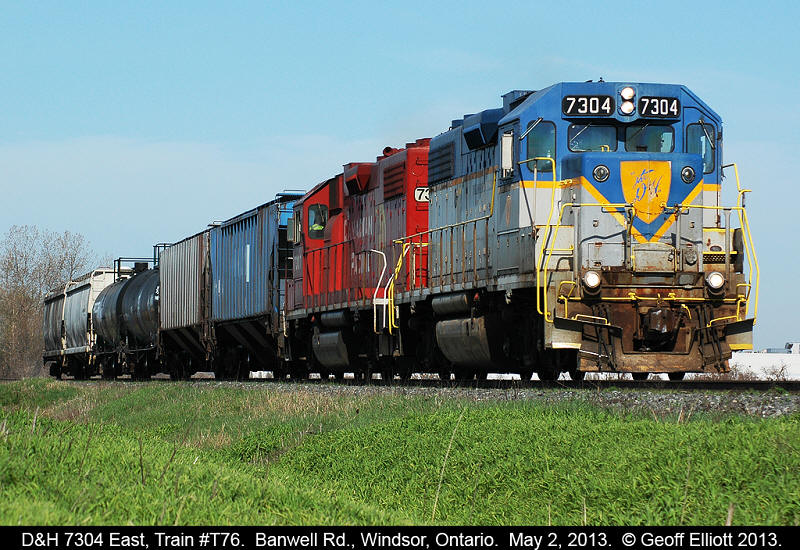
Dennis Weber photographed CP Train H-20. CP-4407, SOO-4429, CP-2207-4418 Kellogg, MN.

GMD-built SD9043AC’s had been Union Pacific Railroad’s railroad’s preferred workhorse engine of choice in the East Kootenay, BC region. However, their time in the UP freight pool is placed on hold due to stress fractures in their frames. UP has removed many from service, and are expected to fix and repair the stress fractures and return them to service. The bottom line is a real variety of power now operates throughout the Cranbrook and Moyie Subdivisions as evidenced in Kevin Dink’s photo. UP GE’s are now the norm here either leading or trailing, while the SD90’s are becoming scarce, Mix this with CP power and you have quite a hodgepodge of power for these parts. Second, CP have added two railroad police officers to patrol the East Kootenay territory for trespassers and such.
CP train 462 with Fisher Peak rising above the Sentinels sizzling over an all GE ES44AC ‘GEVO’ lashup (see website below for details) with CP#9375-8928-8861 and UP#5515 rounding the curve at Galloway.
http://en.wikipedia.org/wiki/
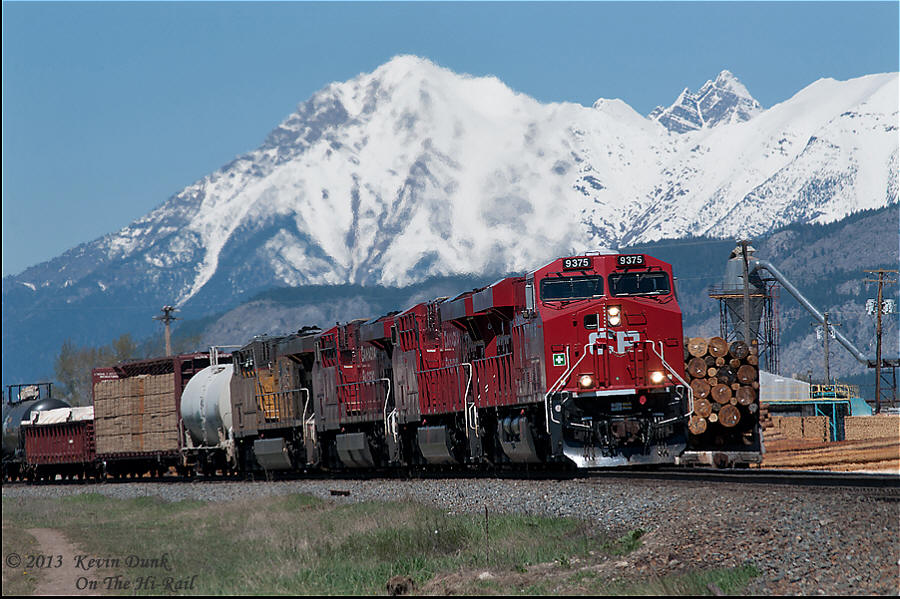
Kevin’s second photo shows an example of the kind of lashup one might find on the UP traffic operating on the CP Cranbrook and Moyie Subs nowadays. CP 472 (empty potash train) is at the apex of the Elko hill (Hwy#3 overpass) with UP ES44AC 5524 , SD9043AC 8246, CP AC4400CW 8533 and UP ES44AC 5501 on the curve, about to descend into the Elk River Valley. If you look carefully you can still see the trailing segment of the potash train above the Burton Lake Road.
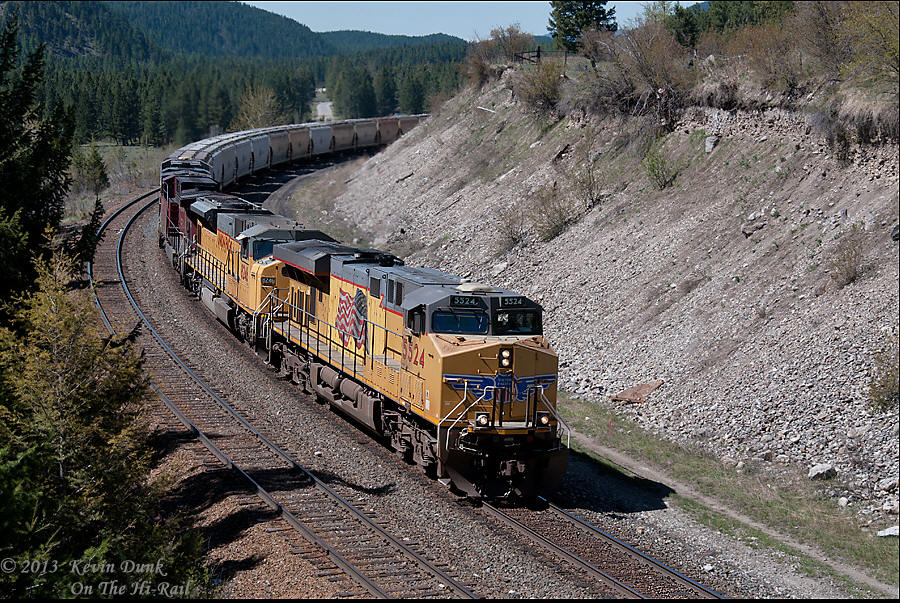
Patrick DeLarue snapped CP N65-18, at Baldwinton, Saskatchewan on May 18, 2000. With a trip of GP39-2’s.
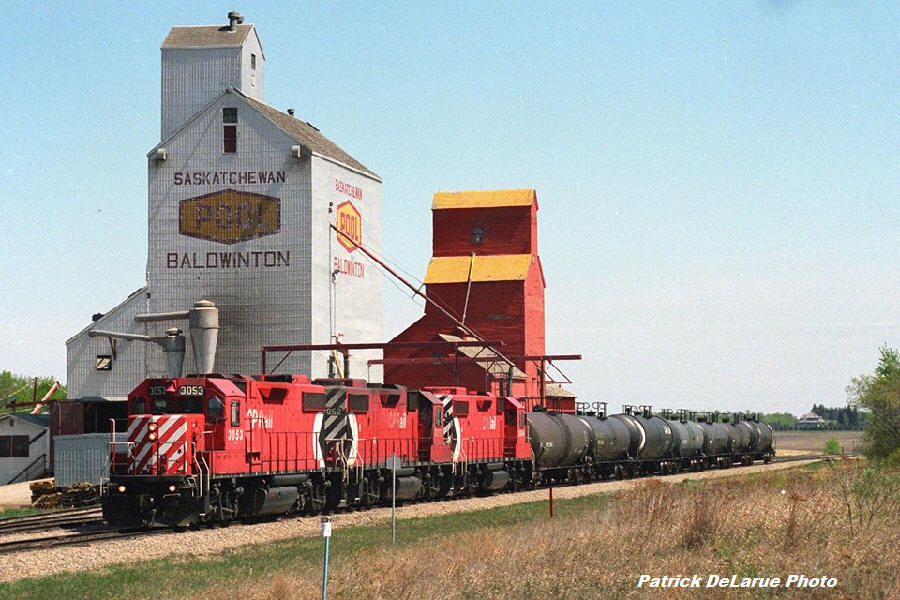
On Good Friday Ron Visockis was in Havelock, ON and bagged CP GP38-2 3117 and sisters (3117-3067) and a Soo line caboose.
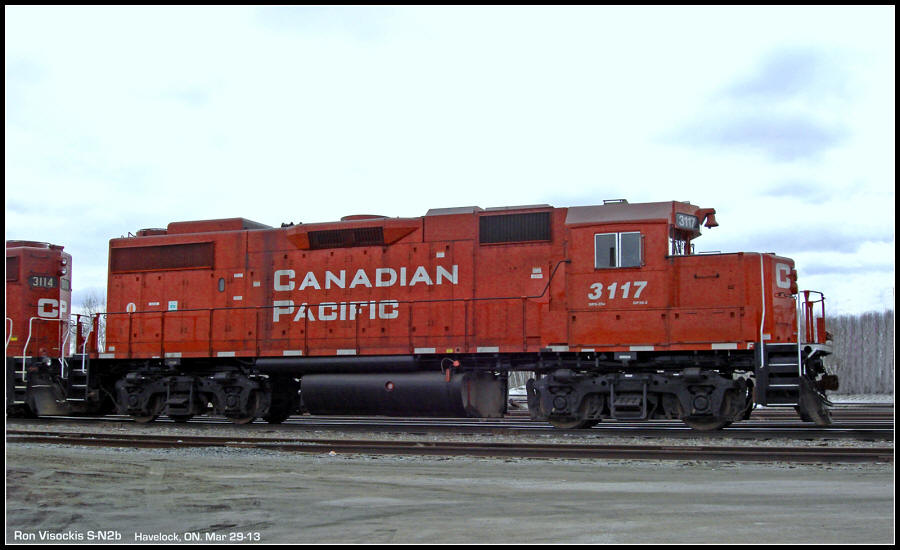
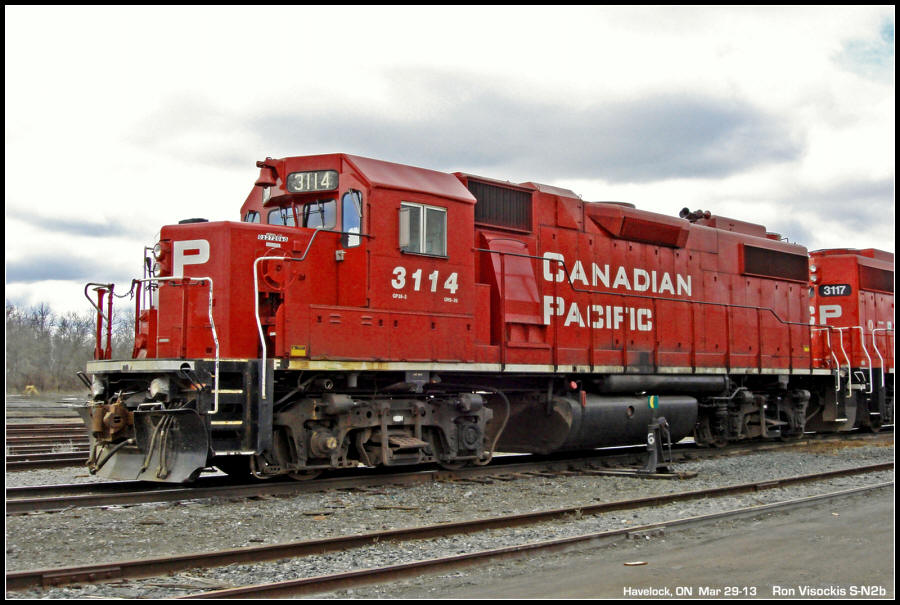
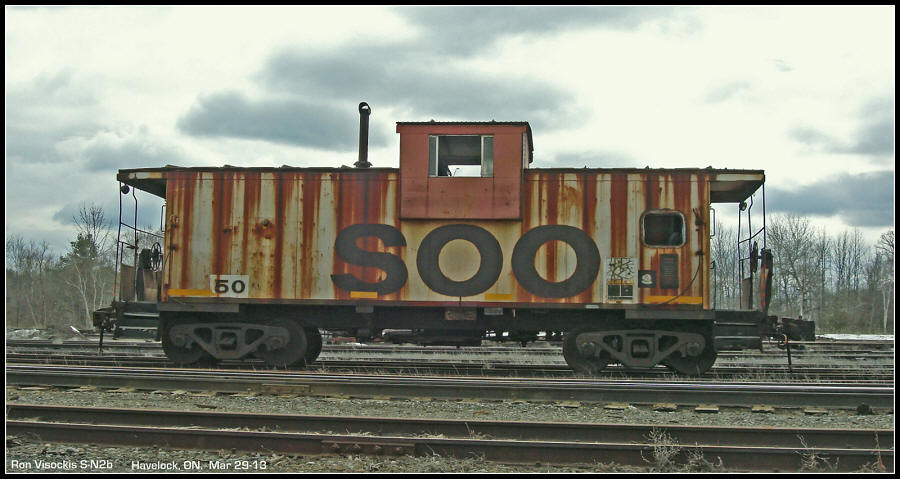
At Mile 60.0 on the Cranbrook Sub, CP 8798 is working its way eastbound assisted by mid-train DPU CP 8602 and rear DPU CP 9538 with an empty coal train approaching the imposing grade at Elko, BC on January 27th.
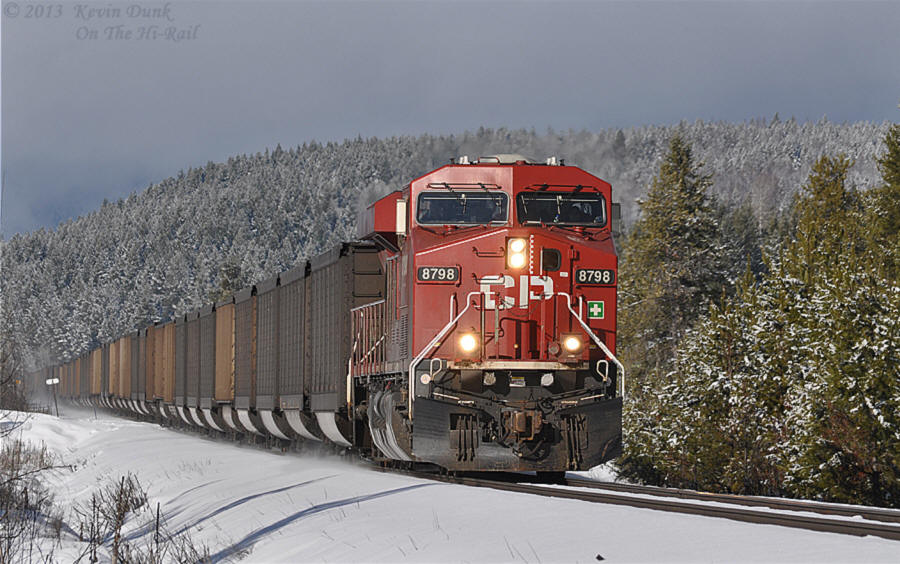
On May 18, 2013, Nathan Brown’s friend Lisa Morin, took these pictures while visiting CP Toronto Yard, and shared them with us. Most of the lineup are units stored unserviceable and included (stored) CITX SD40-2 3024, 3083, 3095, and (retired) CP SD40-2 6004, CPRS SD40-2 5787, STLH SD40-2 5593, and CP SD40M-2 5490, CP GP9u 1684 and Slug 1002, a SOO (White) SD40-2, SOO SD60’s 6027, 6035, 6044, and two other CPRS SD40-2’s . The SOO trio are earmarked for CAD overhaul, and the CP SD40-2’s may get cycled into the SD30C-ECO rebuild program at EMD-Progress Rail in Mayfield, Kentucky.
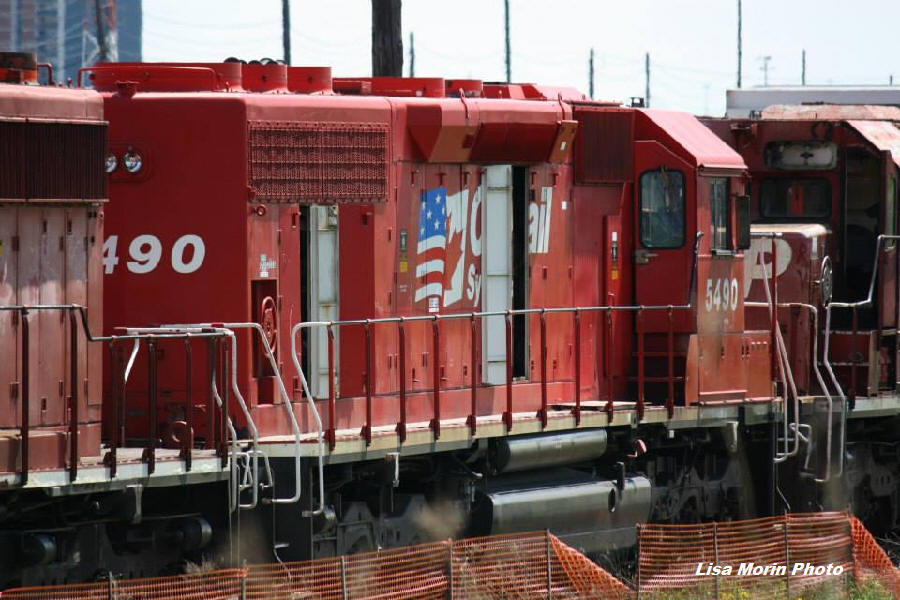
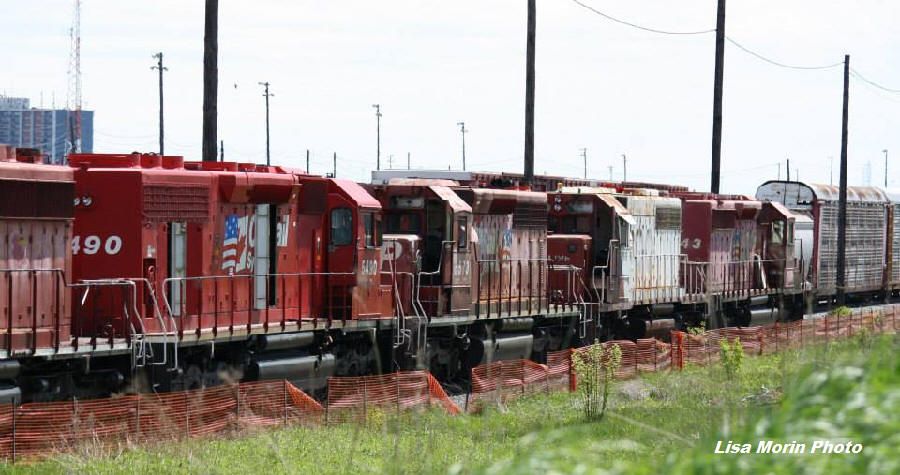

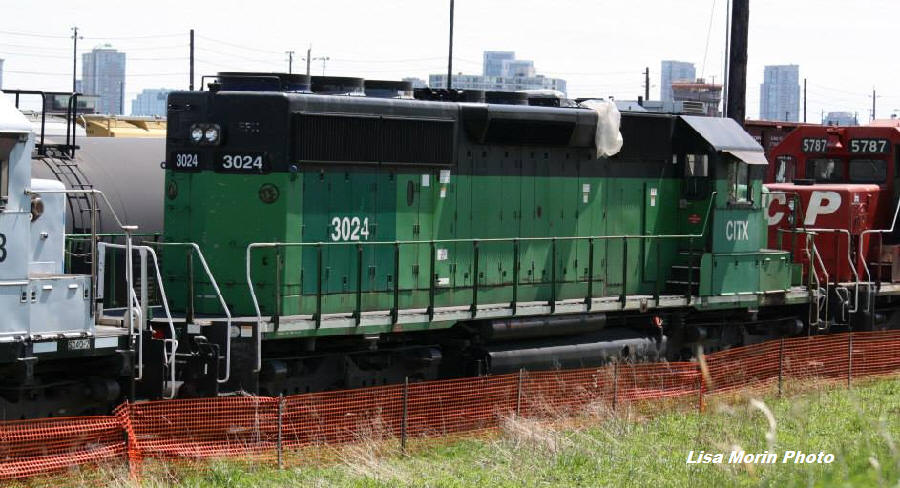
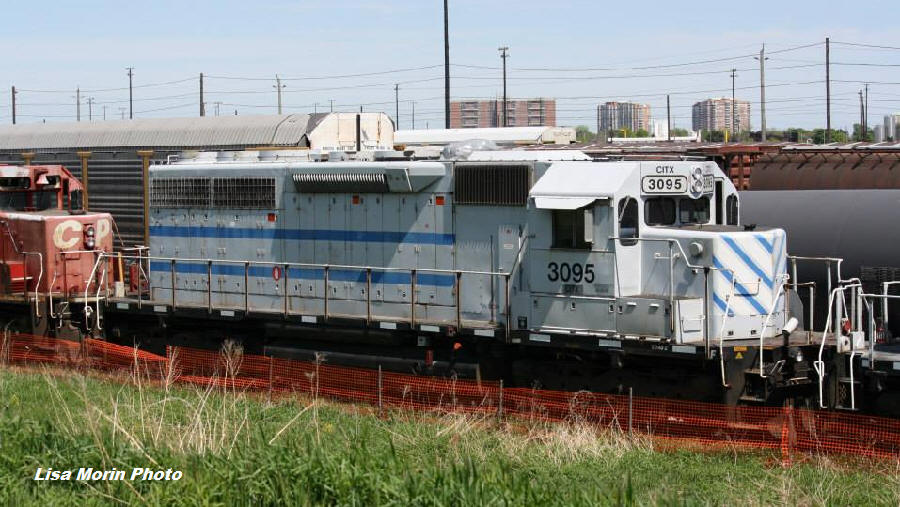
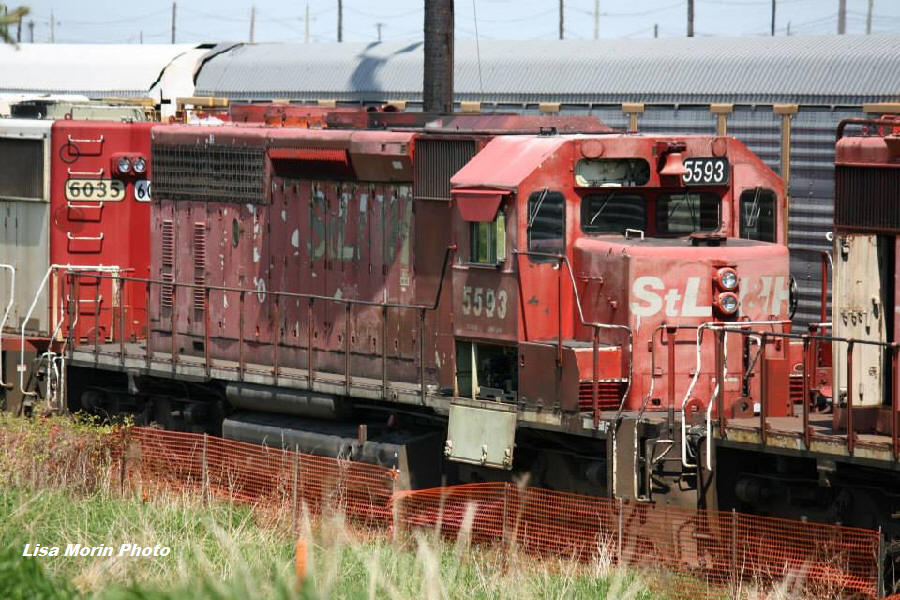
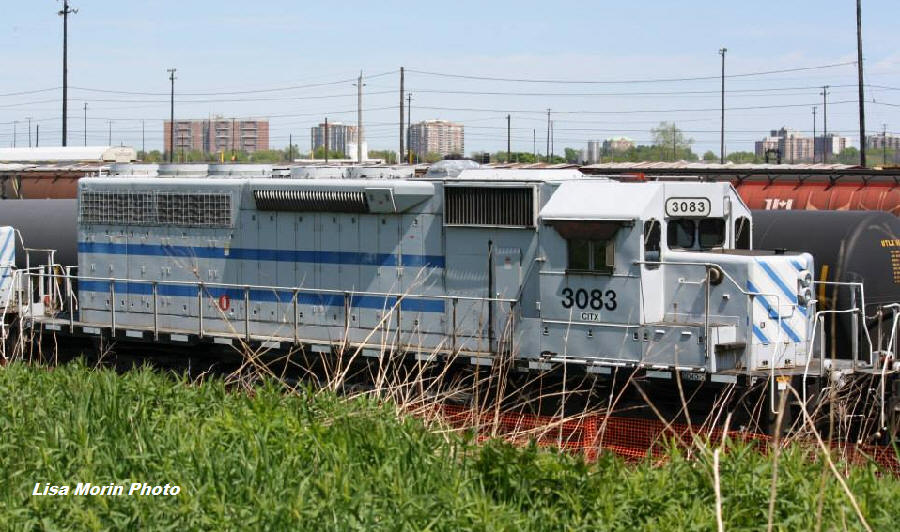

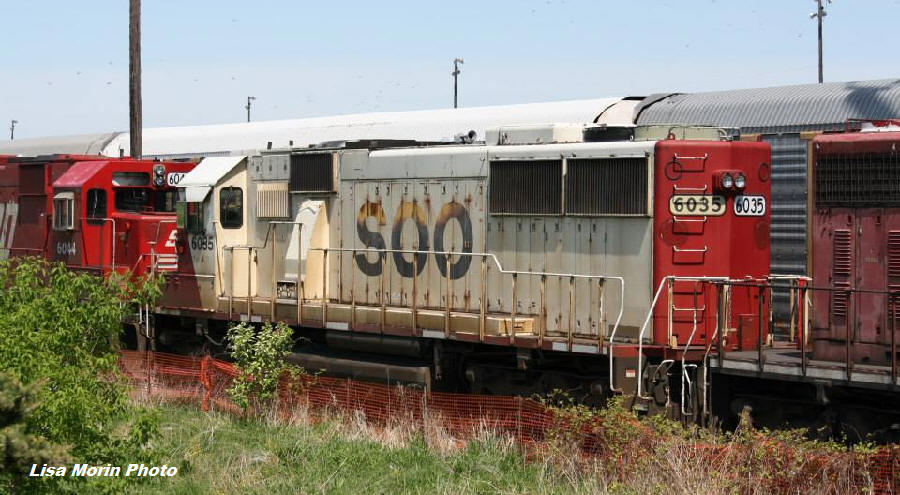
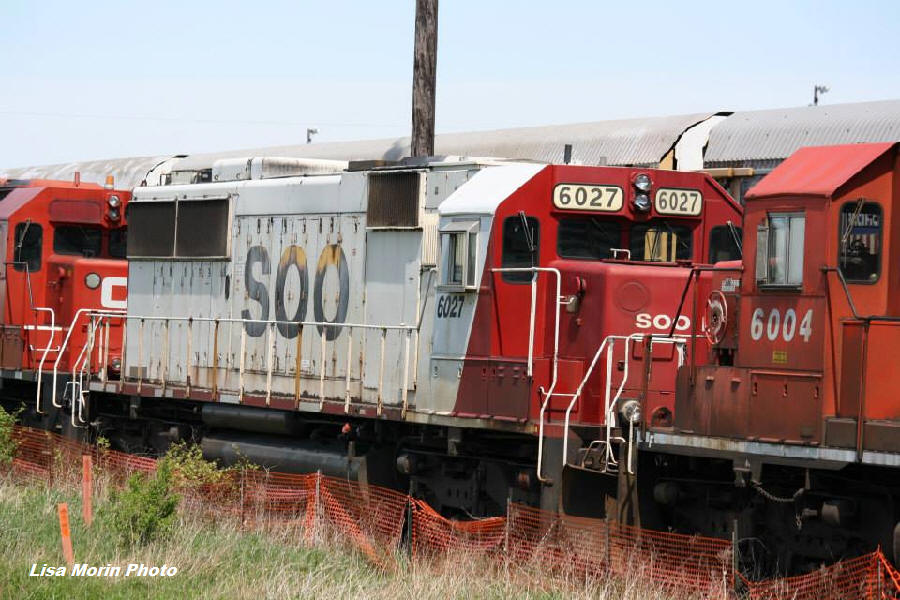
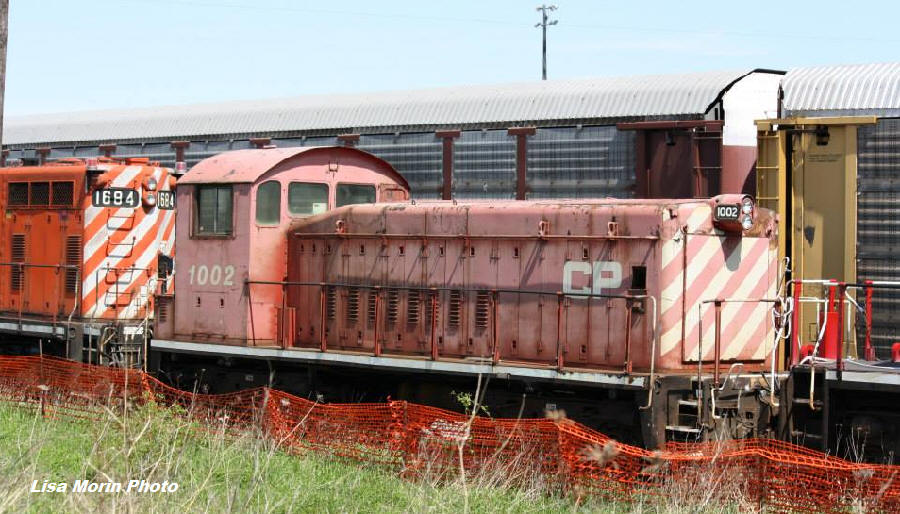
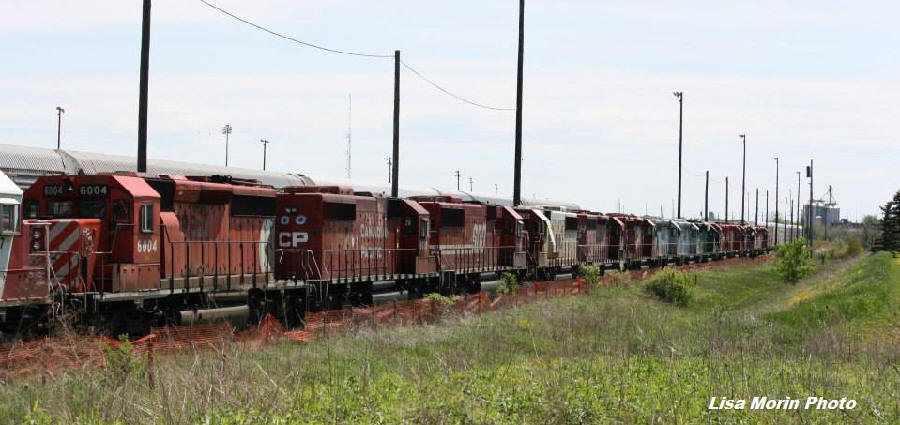
Aivo Merimets snapped the Wolverton Job at the Ayr mileboard with three CP GP38-2s leading a string of multi's. The old code lines poles still exist on much of the OCS part of the Galt Sub, giving this stretch of track some character.
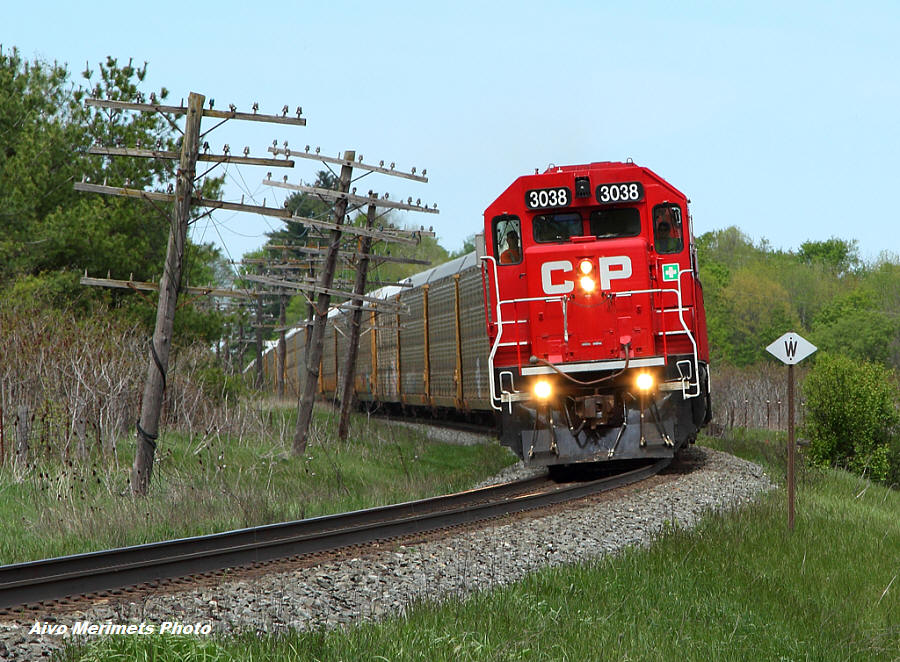
|
CP News |
Canadian Pacific Railway under E. Hunter Harrison:
Forward, Fast
Hunter Harrison’s CP transformation.
(CP Rail)
Surrounded by snow drifts two feet deep, locomotive 9136 rests at the head of a procession of identical engines at a sprawling rail yard in Winnipeg. The cherry-red locomotive is a Model SD90MAC, a 4,300-horsepower workhorse that spent the past decade and a half hauling heavy freight and intermodal trains. Now it sits idle, along with dozens of others—an unusual sight at a yard that rarely sees so many idle locomotives. The last time they lingered here was during the recession in 2009, but the fleet was pressed back into service the following spring when the economy picked up. This time is different. It’s unlikely these engines will see action again—at least not with Canadian Pacific.
CP overhauled four locomotives in the past two years—it clearly intended to use them for years to come. But that was before grizzled railroad veteran Hunter Harrison came to power following a brutal putsch by U.S. hedge fund Pershing Square last year. Pitching himself to shareholders, Harrison vowed he’d turn the least efficient of North America’s Class 1 railroads into the leanest and meanest in a few short years. SD90s are often accused of being unreliable and inefficient, and anything matching that description at CP today is toast. Late last year, the company tendered virtually its entire fleet of SD90s (58 of them) for sale. It offered eight for scrap in January.
Harrison hasn’t yet reached the end of his first year as CEO at Canada’s No. 2 railway, which reported net income of $484 million last year, but his radical transformation of CP is well underway—and by most reckonings, it’s running ahead of schedule. When he assumed the position last June, he promised to slash costs while raising service levels, and he’s moved quickly on both fronts: fewer train crews go to work each day, thousands of workers have already been turfed, and CP’s remaining fleet is pulling heavier loads. Only a few months into his tenure, analysts at Raymond James credited Harrison with “already effecting significant operational improvements.” In February, he hired president and chief operating officer Keith Creel, a protege with whom he’d worked previously, clearing up questions about his eventual successor. Investors can barely contain their enthusiasm for the changes afoot at the company. They’ve bid up CP’s stock above $120 a share; most sell-side analysts have Neutral or Sell ratings on the stock, but that primarily reflects concerns about whether Harrison can deliver results justifying the stock’s already rich valuations. Few question his approach.
As Harrison is fond of saying, CP is no place for anyone who doesn’t like change. A consummate storyteller, he portrays this transformation as unfolding against a harmonious backdrop of co-operation between CP’s management, employees and customers. Yet there will inevitably be winners and losers; Pershing Square clearly intends to be in the former camp. But what’s good for investors isn’t always good for customers or employees—any more than it is for rusting locomotives. If history is any indication, Harrison will pay their complaints little heed.
Few shed tears for CP’s previous board and management team. Those measuring a railroad’s efficiency often consult the operating ratio, which measures operating costs as a percentage of revenue (lower is better). Under CEO Fred Green, CP’s stood above 80% —the worst in the business. Harrison vowed to reduce it to the mid-sixties by 2016, by which time he plans to retire. To accomplish that, he’d have to overhaul the company.
Hunter Harrison (Photo: Spyros Bourboulis)
He’d done it before—at CP’s biggest competitor, Canadian National Railway. Harrison came to CN, a former Crown corporation that had been recently privatized, in 1998 when it bought Illinois Central. As president of the once moribund American railway line, he’d transformed it into a super-efficient powerhouse; CN, grasping his genius, appointed him chief operating officer, later elevating him to CEO in 2003. In doing so, it committed itself to Harrison’s “precision railroading” philosophy. Although the term’s meaning is ambiguous, traditionally many railroads preferred to delay train departures until they were hauling as much cargo as possible. The problem with this approach is that it meant crews and locomotives stood idly, waiting for trains to fill, and customers had little certainty about arrival times. Harrison addressed that by putting CN’s trains on more rigid schedules, a strategy that allowed the company to squeeze more value out of its assets. CN’s operating ratio fell like a stone. By the time he retired in 2009, virtually all competing railroads were imitating at least portions of his approach.
Yanked away from his two retirement passions—golf and horse breeding—by Pershing CEO Bill Ackman, the 68-year-old veteran is applying the same tested template at CP. The difference this time: he’s giving himself a much tighter timeline. “He’s condensed all these things that he believed were successful at CN,” says Doug Finnson, vice-president of the Teamsters Canada Rail Conference, “and he’s implementing them over a very short period of time.”
He’s begun by shutting down anything that seems inefficient. He has closed four of CP’s “hump yards,” for example, which use gravity to sort inbound cars into collection tracks based on where they’re heading. Such yards were conceived during the 1950s to handle a thousand or more cars a day, but changing traffic patterns left CP’s underused. He’s also closed or combined several intermodal terminals (hubs designed for the transfer of shipping containers).
Since moving from Montreal in 1996, CP has been headquartered in downtown Calgary. Under Harrison, it’s now building a new headquarters to the southeast at its Ogden Yard, a move expected to save at least $15 million a year. But it’s not just about savings—it’s about reminding managers they don’t work for an oil company or investment bank. Harrison wants them to see graffitied freight cars when they look out the window. He’s also ordered hundreds of them back to school to learn how to run locomotives and work in rail yards.
Early evidence suggests his strategy is working. CP’s trains spent less time languishing in terminals last year, and average velocity rose 15%. Increased efficiency means CP can do more with less, allowing it to remove hundreds of locomotives from service. (Goodbye, SD90s.) It’s also returning thousands of leased freight cars. Observing all this, analysts at J. P. Morgan posed a pertinent question: “Why on Earth weren’t these opportunities pursued before?”
The up-front costs, though, are sobering. Consider Harrison himself. Simply by announcing his candidacy for CP’s top job, he put himself at odds with his former employer. CN promptly cut off his pension and other benefits and sued, alleging (among other things) that Harrison had breached contractual obligations. Pershing Square, which had promised to indemnify him against lawsuits and compensate him for any lost benefits, deftly handed the tab to CP following its proxy battle victory. In 2012, half a year of Harrison’s time cost CP $49 million. (The two companies buried their litigation hatchets earlier this year, and CP recovered US$9 million.)
 There
were other charges relating to labour restructuring and severance agreements for
departing managers. As a result, CP’s already lacklustre operating ratio
actually increased, to 83.3%. (CP diverted attention from that by emphasizing a
modified operating ratio that ignored “significant” items such as “management
transition costs.” By that measure, modest improvement is already evident.)
There
were other charges relating to labour restructuring and severance agreements for
departing managers. As a result, CP’s already lacklustre operating ratio
actually increased, to 83.3%. (CP diverted attention from that by emphasizing a
modified operating ratio that ignored “significant” items such as “management
transition costs.” By that measure, modest improvement is already evident.)
By his own reckoning, Harrison has eliminated 3,000 of the 19,500 positions (including part-timers and contractors) existing when he took over; at a New York investor conference, he mused he may turf thousands more than initially projected. Although much of this is to be accomplished through attrition, one might expect the bloodletting to compromise morale. But when talking to shareholders, Harrison’s message is that what’s good for CP is also good for its customers. For example, the company reports it slashed its customer service department in Winnipeg by 75%, from 800 workers, in favour of a new approach where the people delivering the service are also responsible for keeping the customer happy. And apart from the odd malcontent, he says, there’s almost no push-back from workers. Indeed, in late 2012 he signed five-year agreements with United Steelworkers and three other unions. “I’ve never been in a company where people were more ready and willing to change,” he wrote in his annual letter to shareholders. “They are tired of being in last place.”
“That’s bullshit.” Over at Teamsters, which represents CP’s locomotive engineers, traffic controllers and conductors, Doug Finnson invokes that phrase frequently when discussing Hunter Harrison’s latest pronouncements. But the one that really gets Finnson riled is CP’s claim that relations with unions are improving. He regards the overbearing Harrison as a martinet—not an uncommon view among rail workers. Relations were already troubled when he arrived on the scene: last May, Teamsters went on strike, costing CP significant revenue. Parliament ordered them back to work after nine days and forced them to arbitration.
During the arbitration process, CP began cancelling local rules at many of its terminals, including ones governing how locomotive engineers are called to work, in favour of new companywide rules. Teamsters opposed the changes before the Canada Industrial Relations Board. In two decisions, the CIRB found CP had violated collective agreements. In March, the board took the unusual step of filing its latest decision with the Federal Court for judicial enforcement because it expected CP to ignore its orders. “The employer has made it virtually impossible for the labour-relations system to work as it should,” the board observed.
 Unions
weren’t able to stop Harrison’s reforms at CN; they barely slowed him down. But
his approach won’t improve what is already a climate of mutual suspicion. CP
casts locomotive and rail-yard courses for managers as a way of spreading
passion for railroading throughout the company. Finnson calls it Union Busting
101—preparing management to run trains in the event of a strike. “He’s doing the
same thing he tried at CN,” Finnson claims. “He trained people to become
conductors and locomotive engineers.…When conductors went on strike, they used
managers to do their jobs.”
Unions
weren’t able to stop Harrison’s reforms at CN; they barely slowed him down. But
his approach won’t improve what is already a climate of mutual suspicion. CP
casts locomotive and rail-yard courses for managers as a way of spreading
passion for railroading throughout the company. Finnson calls it Union Busting
101—preparing management to run trains in the event of a strike. “He’s doing the
same thing he tried at CN,” Finnson claims. “He trained people to become
conductors and locomotive engineers.…When conductors went on strike, they used
managers to do their jobs.”
Finnson says the union fears CP will become a more dangerous place to work. Harrison has emphasized the importance of safety virtually his entire career, but some question his approach. According to a 2007 federal safety review of the railway industry, during the early 2000s the number of railway accidents in Canada—particularly main track derailments—sharply increased. The review panel praised CP for making “great strides” to developing a “healthy safety culture.” Harrison’s CN, by contrast, got lambasted for adopting a rigid rules-based system under which employees were more often suspended or fired for mistakes. This, according to the panel, created a “culture of fear and discipline” that compromised safety rather than improved it. Finnson reports that Harrison is replicating that approach at CP. The company recently saw derailments in Minnesota and northern Ontario, both of which resulted in oil spills, but it’s too early to draw conclusions about the causes of either accident.
For customers, the implications of Harrison’s strategy seem more ambiguous. “CN does a better job of getting there when they say they will,” offers Ian May, chair of the Western Canadian Shippers’ Coalition. “In terms of their standards and the way they operate, they’re much better.” As for CP’s service pre-Harrison, “it was bad. The grain guys were particularly vexed. I would expect him to clean that stuff up. But you’ve gotta realize, the bar is pretty stinkin’ low.”
Harrison argues improvements will follow from making the railway more efficient. That already seems evident in more competitive markets such as intermodal service between the Port of Vancouver and major centres like Chicago and Toronto. CP reports it has knocked a full day off its Vancouver–Chicago service. Analysts at Raymond James considered that “testament to the compatibility of reducing costs and raising service.” Cormark Securities recently predicted that competition between the two national railroads will rise, which implies further service improvements.
Shippers’ advocacy groups are hardly convinced, though. “When Hunter Harrison was at CN, the results were pretty mixed,” says Bob Ballantyne, chairman of the Coalition of Rail Shippers. May concurs. Although CN’s service remained largely unchanged after Harrison’s retirement, the company adopted a gentler approach to customer relations. “One of the problems with Hunter was, he was pretty gruff,” May says. “It was hard to get anything but a ‘screw you’ out of CN if you were complaining.”
By way of illustrating how efficiency and service sometimes clash, May recalls a branch line in Alberta, on which CN served four companies with a 120-car train. One of the customers doubled its business, and wanted 80 cars instead of its usual 40. But a 160-unit train was too long, and CN balked at adding another train. “The response by the railway, initially, was to not give them the service they wanted,” May recalls. “And when pressured, they took away cars from the other customers on that line. But nobody ended up getting what they needed.” Customer service, he says, became thoroughly subordinated to driving profitability for shareholders. “That’s really what’s at the core of what’s wrong with Mr. Harrison’s model.”
Some customers fear CP’s service is now suffering. “Some of our members have expressed concern over how much service, attitude and communications have deteriorated at CP over the last several months,” says Susan Murray, spokesperson for the Forest Products Association of Canada. But customers probably have less leverage than the unions. Their best hope was the Fair Rail Freight Service Act bill, the result of years of complaints and lobbying about rail service in Canada. Unveiled in December, it would give shippers new rights to service contracts with railways, and a new system to resolve disputes. But May calls the legislation underwhelming, saying it benefits railways more than shippers.
Harrison’s template, then, faces few credible external obstacles. And with several of CP’s business lines (notably oil shipments by rail) enjoying robust growth, the wind seems to be at his back. Some, like Finnson, question how much progress Harrison has made, suggesting that he may be taking credit for initiatives predating his arrival. For example, Finnson claims the planned move to Ogden Yard had been talked about for at least three years. But while Finnson intended that at a criticism, it could equally be regarded as further proof CP was far too bureaucratic under its previous management. Under the previous CEO, the company could conceive of sensible measures to save money. Under Harrison they get implemented—and quickly.
On May 4th, the Revelstoke Fire Department was called out to fight a fire on a CP Rail bridge in Revelstoke just after 7 p.m. CP spokesperson, Kevin Hrysak, said the fire was on the east side of the Columbia River and about two railcar lengths in size., Fire crews and a helicopter were called to contain the blaze and the fire was extinguished by 9 p.m. The cause of the fire is still under investigation. The bridge will need to be repaired before it can be used again. One report we received suggested the fire may have started by one of the GE locomotives on a slow moving heavy coal train as they slowly crossed the bridge into town, however CRO cannot confirm this and we have no further details.
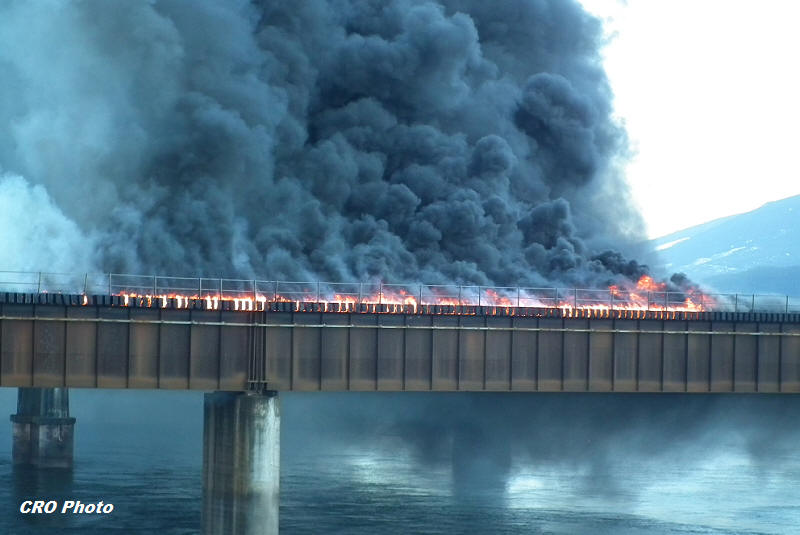
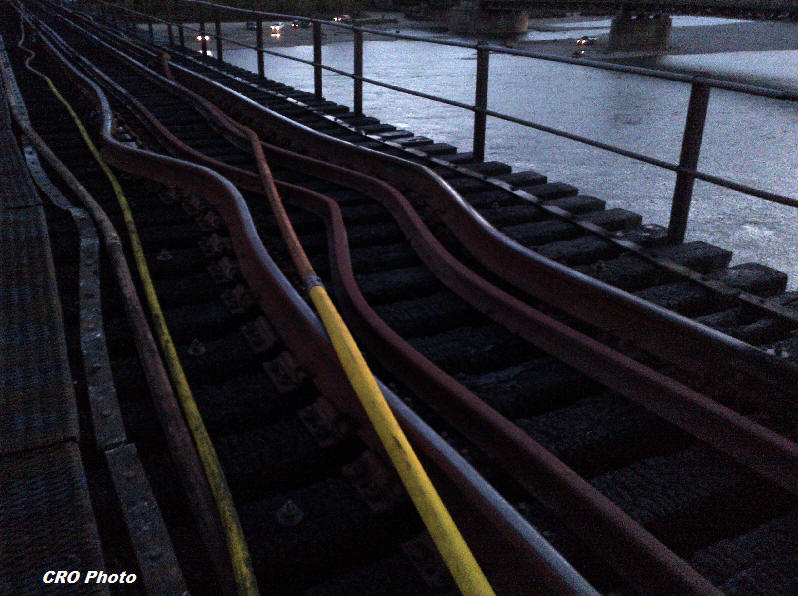
In late March, a CP train derailed in western
Minnesota, spilling 57,000 litres of crude on the frozen ground alongside the
derailment. That incident was followed by another derailment a week later, in
which another 64,000 litres of crude was spilled on the ground outside of White
River, Ont. (the birthplace of the real Winnie the Pooh.) In May, another CP
potash train derailed near Provost, Alberta. It's an undoubtedly difficult start
to the year. The series of high-profile derailments at CP in recent weeks have
come at a bad time for both the railway and its new chief executive, Hunter
Harrison. They also come at a time when CP is in the spotlight both because of
dramatic ongoing restructuring, and because of the highly charged debate
currently taking place about whether it is safer to ship crude by rail or
pipeline. CP has said the incidents — even though they came in fairly quick
succession — were isolated events. The first derailment was caused by an
`internal flaw' in the track that went undetected until it snapped. In the
second and third incidents, broken wheels were the culprit.
Mr. Harrison is steadfast as ever that the operational efficiencies he has
implemented at CP since being appointed chief executive last June were not
behind the derailments, and that rail remains a safe alternative for shipping
oil. "Are we never going to have an accident? No," Mr. Harrison told reporters
after CP's annual general meeting. "I don't know of any mode of transportation —
whether it's pipeline, air, rail — that [hasn't] had accidents." CP has long
marketed itself as the safest railway in North America. So it is understandable
that chief among the concerns of those who opposed Mr. Harrison' s appointment
as CEO last year during a messy proxy battle waged by Bill Ackman's Pershing
Square Capital Management LP was his controversial track record for safety while
he was at the helm of rival Canadian National Railway Co. Mr. Harrison cautioned
that those numbers should be viewed with some caution, in part because CP was
now running longer, more efficient trains, which reduce the amount of
train-miles and therefore distorts the impact of such events. He also argued the
derailments this year were less severe — something those figures don't catch.
Mr. Harrison said the railway' s board did, however, approve up to $75-million
in additional spending this year to upgrade CP's secondary lines between
Edmonton and Winnipeg and in North Dakota where the bulk of the heavier crude,
potash, and grain trains would be running. That is in addition to the
$1.1-billion the railway committed for capital spending.
Mr. Harrison said most of the upgrades were slated for 2014 and 2015 but were
pushed ahead because of the company' s strong cash position. He said it would go
toward fixing ballasts, ties and rail that were "not up to speed."
As a result, Keith Creel, CP chief operating officer, said the company was
adopting new technology to improve early detection of the sort of defects on the
rail line or wheels that led to the derailments earlier this year. "Safety is
and always will be paramount. It's job No. 1," Mr. Creel said. But Mr. Harrison
said there were other areas that could be addressed as well, including better
training for CP's employees.
"Some of these things, if you really peel back to the root cause are behavior
issues that we also need to manage," he said. For example, if the brakes are
applied incorrectly on a train and it slides, this can create flaws in the
wheels that allow moisture to get in, he said. "I don't want to make the
impression that these are things beyond our control," he said. "So, we'll be
attacking it from a human behavior standpoint as well as technology standpoint."
Kevin Barnes, an equity analyst with Kerrisdale Capital Management LLC, which
holds a short position in CP, said he doesn't believe the additional
infrastructure spending will be sufficient for the amount of heavier trains
running on those lines.
Canadian Pacific increases 2013 capital investment program:
Canadian Pacific announced the company will move forward certain capital
spending projects originally targeted for 2014 into this year, funded by a
higher than anticipated 2013 cash-flow projection. As such, the company will be
investing an additional $75 to $100 million into its 2013 capital investment
program. "As our railway continues to transform, we see opportunities to
accelerate enhancements to key sections of our North American system," said
Chief Executive Officer, E. Hunter Harrison. "By taking these opportunities now
to further improve our operations, we will be better positioned to respond to
our customers' shipping needs." The projects are primarily focused on
productivity, safety and efficiency, highlighted by the following:
• Advance track upgrade work on the North Main Line between Winnipeg and Edmonton
• Upgrades to signaling systems on CP's main line between Moose Jaw and Chicago,
which will improve productivity and increase capacity to meet shipping growth
• Achieve further expense savings and strengthen the balance sheet by
opportunistically acquiring core assets that would otherwise be leased
Source CP
One of the CP St-Luc yard crews was backing up a cut of cars hen the softly hit
a Bruce R. Smith tractor trailer that was crossing the track inside the yard.
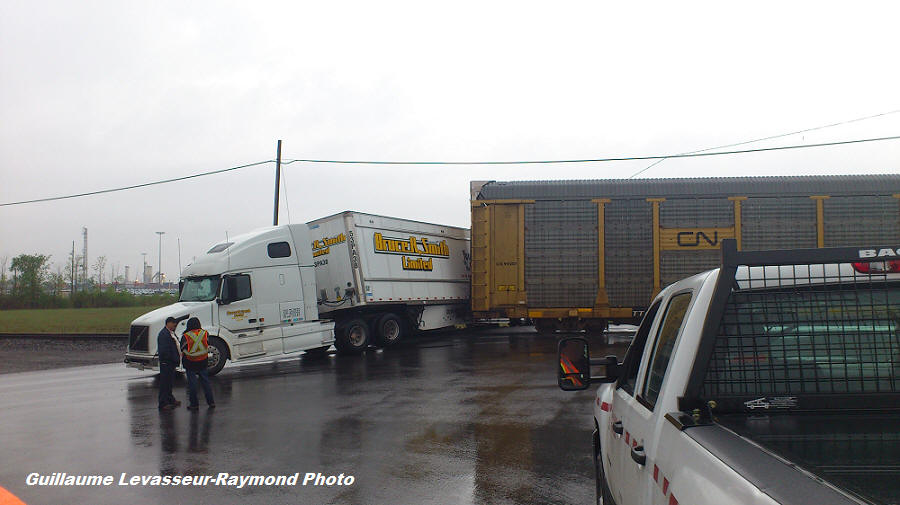
In mid-May, the Canadian Transportation Safety Board (TSB) sent a team to the site of a two-train collision on the CP line east of Medicine Hat, AB. Officials said one CP freight train hit another May 18th in the afternoon. One person was injured and taken to hospital. "Our investigators are currently en route to the scene," said John Cottreau, manager of media relations for the TSB. "They'll be looking at things like rail, they'll be downloading information from the train locomotive event recorders and they'll be looking at a variety of issues." Couttreau said there were no dangerous goods released as a result of the accident. One train apparently rammed into another, according to the TSB. The train that was struck had two cars derailed and the train that collided into it derailed two locomotives and one car. Officials don't have an exact time for the accident and are only saying that it happened Saturday afternoon. The TSB will gather information and assess the situation but does not assign fault. It also does not determine civil or criminal liability.
In late April, former Wisconsin Central heavy weight rear platform observation car “Superior” had been relettered to CP 3 at the CN Woodcrest Shop. It is still wearing the WC maroon and yellow paint scheme. This is the third business cars CP has purchased in two months, and will be repainted at either Quality Rail, or Metro East Industries. In March, the Canadian National Railway sold two cars from their executive fleet to the Canadian Pacific Railway which were renumbered CP 2 and CP 1. Track inspection theater car CN 1060 “Sanford Fleming” ( “CP2”), and CN heavyweight platform observation car 1058 (“CP1”) were then moved to Quality Rail in East St. Louis, IL for repaint, The former Wisconsin Central observation, car is seen lettered “CP 3” at the Woodcrest shop April 27th.
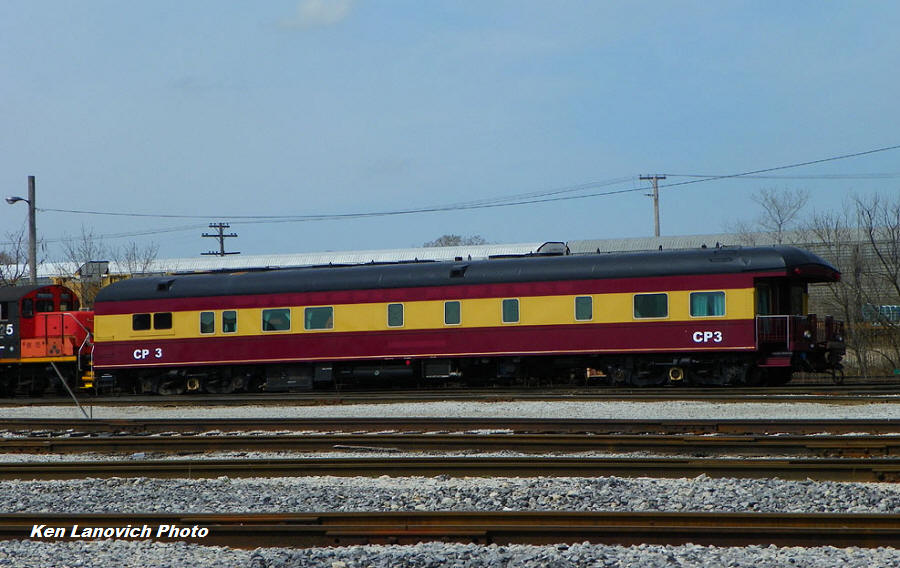
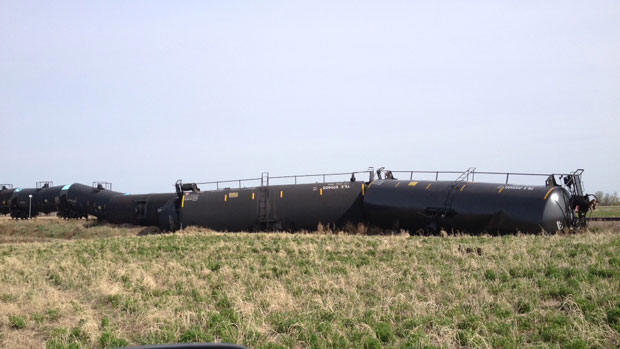 A
64-car CP tank train derailed just west of Jansen, a village southeast of
Humboldt, SK on May 21st. Emergency crews contained crude oil
leaking from a damaged rail car, according to a CP spokesman. The derailment
happened early in the morning about 150 kilometers east of Saskatoon. An
investigation into what caused the derailment is under way, said Ed Greenberg, a
Canadian Pacific spokesperson. All five rail cars that left the tracks were
carrying oil. Greenberg said the 575 barrels of crude oil that leaked from one
of the cars is contained. "We are ensuring that any of the spilled product is
cleaned up," he said, adding that the process includes the use of special vacuum
trucks and the removal of any contaminated soil. The closure affected one of
the main lines in Western Canada, but only the section of track around Jansen is
closed and trains are being rerouted, he said. A CP official said the spill does
not pose a risk to the public. At least five cars are off the tracks, they
said, and about 80 meters of track have been destroyed. Photos from the local
fire department show the derailed cars on their sides in a ditch, and witnesses
said it appears the railbed gave way.
The
following day, the company said it had already repaired and reopened the rail
line near Jansen, Saskatchewan, and were continuing the cleanup. (Photo
courtesy CBC News)
A
64-car CP tank train derailed just west of Jansen, a village southeast of
Humboldt, SK on May 21st. Emergency crews contained crude oil
leaking from a damaged rail car, according to a CP spokesman. The derailment
happened early in the morning about 150 kilometers east of Saskatoon. An
investigation into what caused the derailment is under way, said Ed Greenberg, a
Canadian Pacific spokesperson. All five rail cars that left the tracks were
carrying oil. Greenberg said the 575 barrels of crude oil that leaked from one
of the cars is contained. "We are ensuring that any of the spilled product is
cleaned up," he said, adding that the process includes the use of special vacuum
trucks and the removal of any contaminated soil. The closure affected one of
the main lines in Western Canada, but only the section of track around Jansen is
closed and trains are being rerouted, he said. A CP official said the spill does
not pose a risk to the public. At least five cars are off the tracks, they
said, and about 80 meters of track have been destroyed. Photos from the local
fire department show the derailed cars on their sides in a ditch, and witnesses
said it appears the railbed gave way.
The
following day, the company said it had already repaired and reopened the rail
line near Jansen, Saskatchewan, and were continuing the cleanup. (Photo
courtesy CBC News)
Regarding 'Buffer Car' use on ethanol and oil unit trains (From Jeff Simpson – Froth) Crude Oil does not fall into the same class as other dangerous commodities in Canada and therefore does not require a buffer car by Canadian regulations. However, it does require a buffer by US regulations, and hence any train running in the US, or through a portion of the US (like CP-MMA trains to St John) require a buffer car. As all
unit trains of crude oil on CP currently travel to the US, or through the US, all CP crude oil trains have buffers. Usually customers are required to supply the buffers, so they tend to travel through to Canada as setting them off and picking them back up would be a logistical nightmare. In the future, if there are any pure Canadian routings for crude oil trains, they will likely not have buffers. Most Class 1 carriers are lobbying the FRA to get an exemption for buffers between remote locomotives and crude oil cars. The risk is lower if there are no employees present on remote locomotives. Therefore you may only see head end buffers in the US and not necessarily mid train or tail end buffers when remote locomotives are present.
Rescuers called to the scene of a train derailment found the train's engineer and conductor sitting atop one of the derailed locomotives in an area surrounded by rising floodwaters. No one was injured in the late Monday night *May 20th derailment of the (DME) Canadian Pacific train, and the rail workers were safely rescued. Railroad spokesman Ed Greenberg said the derailment was caused by a washed-out rail line. Five cars, four of them carrying ethanol derailed. The three derailed locomotives were a DME SD40-2 (on its side) and two CSX GE’s that remained upright. Railroad inspectors initially reported none of the ethanol leaked, but Tuesday night the Iowa Dept. of Natural Recourses confirmed ethanol and diesel were leaking into the Little Cedar River, IA The DNR says one of the ethanol cars has been punctured, resulting in a slow leak.
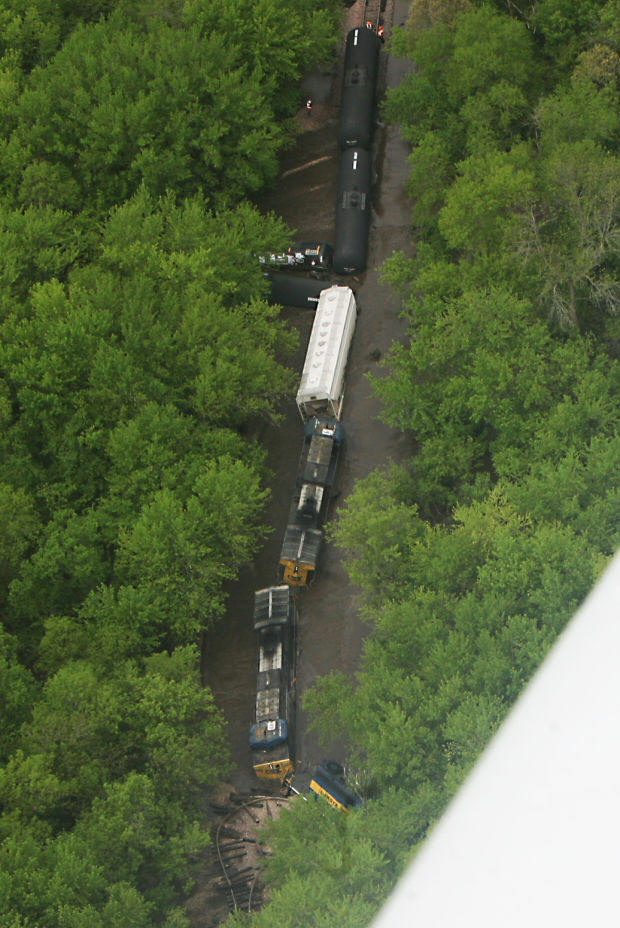
Canadian Pacific Railway intends be a "more aggressive" buyer of short-line regional railroads as it improves its financial performance and operating efficiency, Canada's second-largest railway said on March 22nd. In a sign of where he plans to take the company after an aggressive program of cost cuts and service improvements, Chief Executive Hunter Harrison said CP will play a bigger role than in the past in the consolidation of the railway industry. "It'd be hard for us to put together the wherewithal to be able to make an acquisition of a Class One (railroad), that's just probably not in the cards for some time," Harrison said in a webcast presentation at a transportation conference. Harrison was an active dealmaker when he ran rival Canadian National Railway from 2003 to 2009. "We certainly will become, along the short-line regional front, more aggressive than we have been in the past." Harrison did not identify any targets, but said he did not agree with a recent report that CP or CN should buy Kansas City Southern Railway Co to gain access to the growing Mexican market, calling the idea a "worn out" story. During Harrison's tenure at CN, the company bought BC Rail, operating in British Columbia; the Bessemer and Lake Erie Railroad in Pennsylvania and Ohio; the Duluth, Missabe and Iron Range Railway in Minnesota and Wisconsin; and the principal lines of the Elgin, Joliet & Eastern Railway, running between Illinois and Indiana. Shares of CP fell 21 Canadian cents to C$139.76 on the Toronto Stock Exchange on May 22nd
|
CP Vignettes |
On August 5th, 1073 CPR SW1200RS 8171 is on the ground after running over a derail as she was leaving the Algoma Central transfer yard in Sault Ste Marie, Ontario. Note she just missed hitting a power pole before landing and sliding into the ditch. ACR GP9 171 is ready to help pull the CPR engine out with a steam powered hoist is behind the CPR unit to lift it up and set her back on the rails.
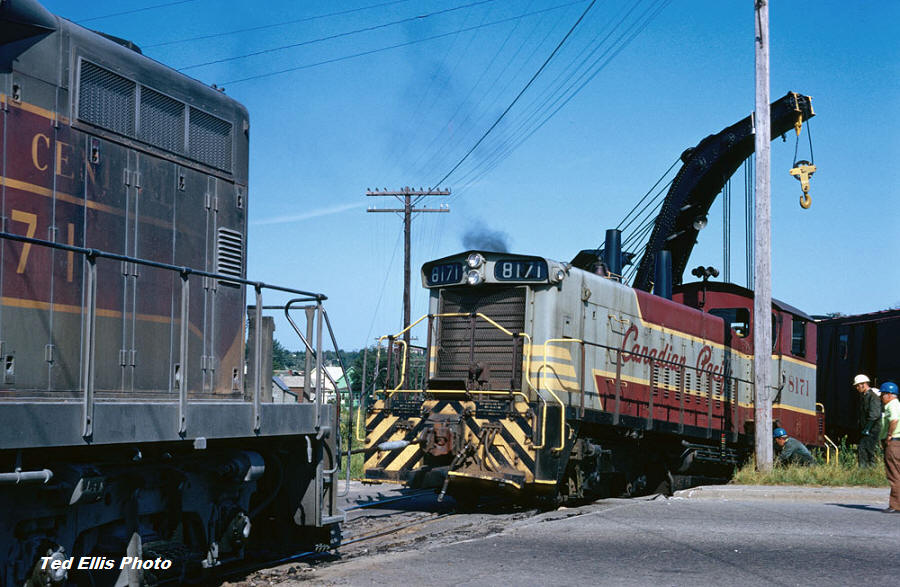
Peter Cox kindly shared the following great CP shots from the early 1960’s, and all scanned from his extensive photo and slide collection.
CPR S2 7102 and FP7A 1432 at Winnipeg, MB Aug 13, 1964.
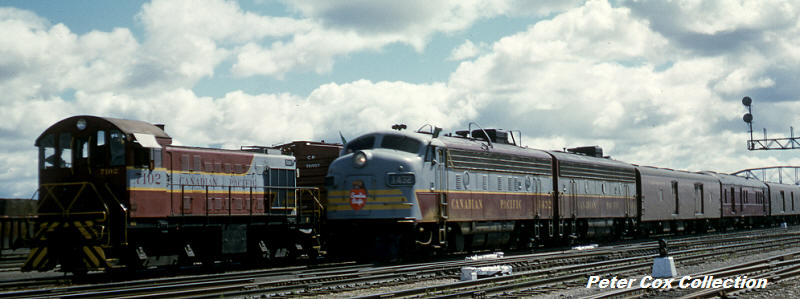
CPR SW1200RS 8100 in Winnipeg, MB Sept 16, 1964.
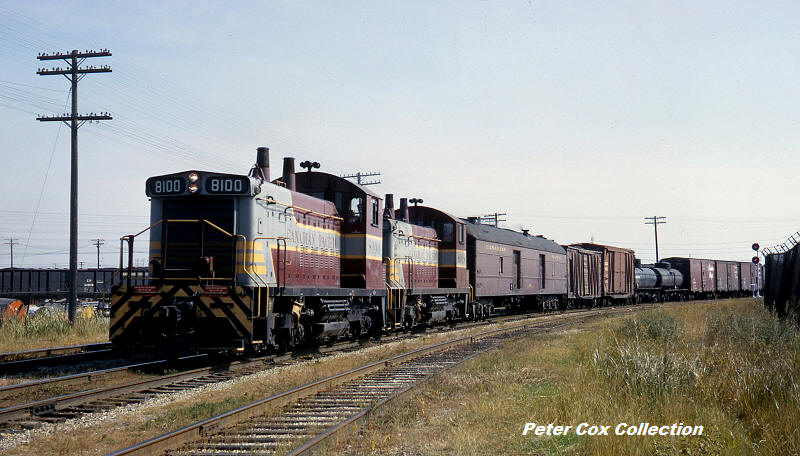
Running elephant-style CPR SW1200RS 8165-8166 196 lead a mixed train in Winnipeg, MB Sept 12, 1963.
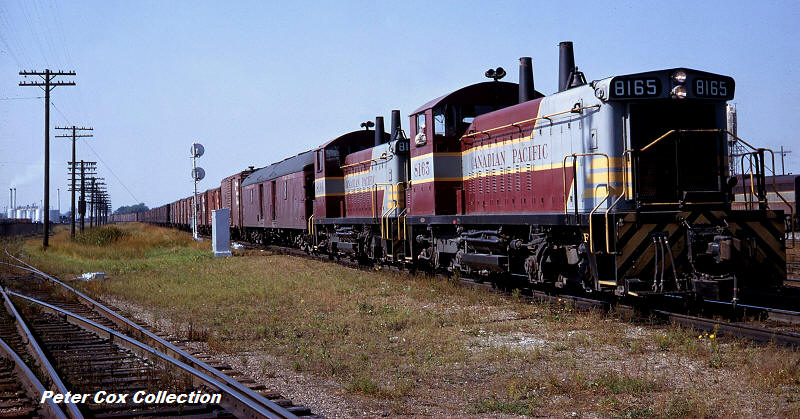
CPR SW1200RS 8169 at Winnipeg, MB Sept 16, 1964.
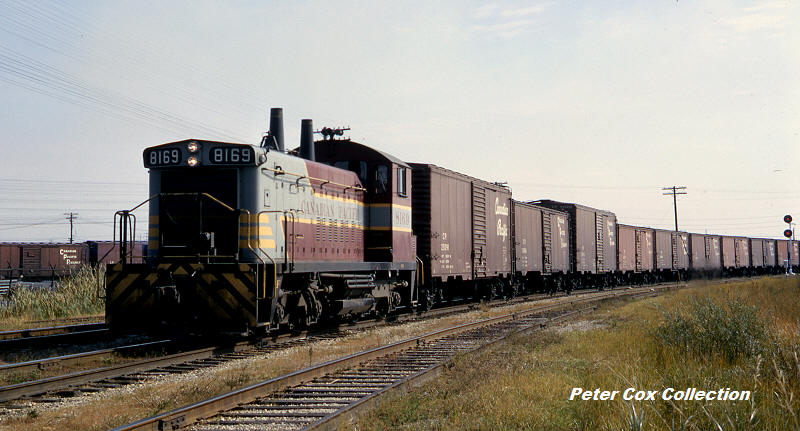
Only months old and back to back, CP’s only GP30’s (CPR 8200-8201), look lovely about to depart Winnipeg, MB with a second section consist on Sept 20, 1963.

CPR GP9 8485 in Edmonton, AB Sept 8, 1963. PHOTO
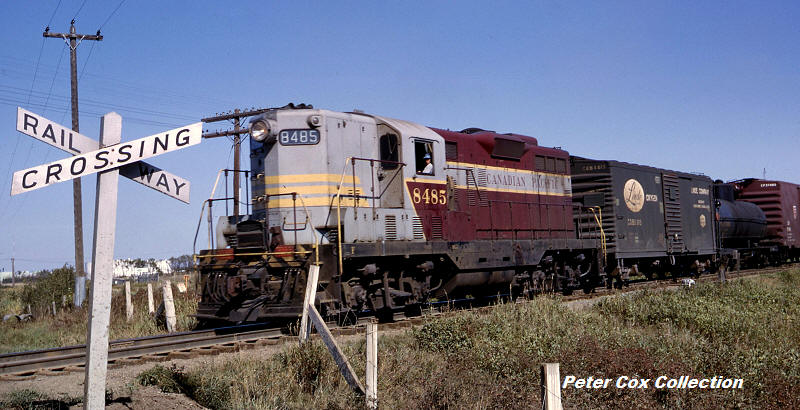
CPR GP9 8817-8543 Winnipeg, MB Sept 12, 1963.
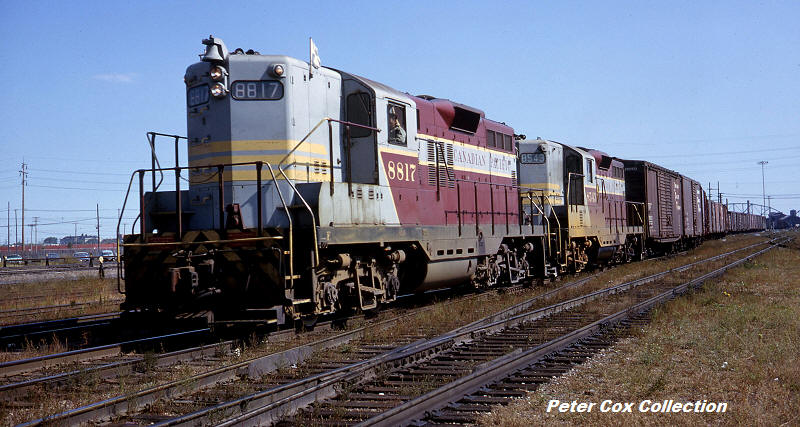
CPR GP9 8835-8643 Winnipeg MB Sept 12, 1963
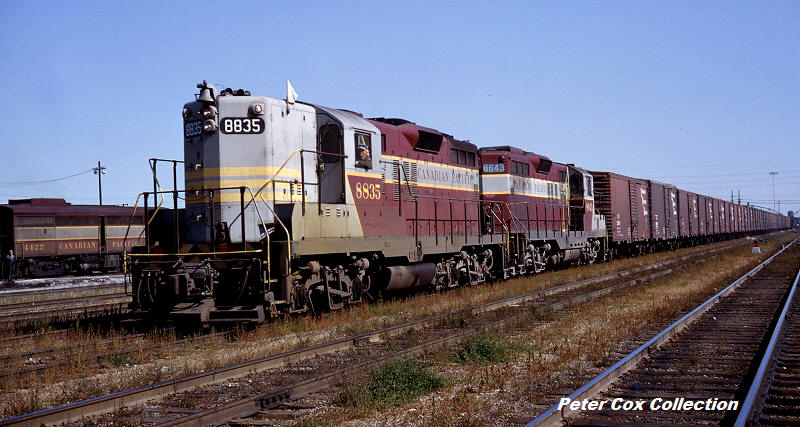
CPR 8915 Winnipeg MB Sept 16, 1963.
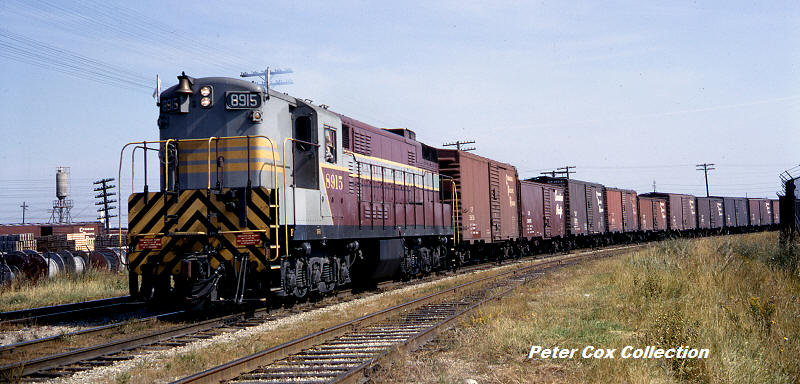
CP Rail M636 4728 at Winnipeg, MB Jan 16, 1979.
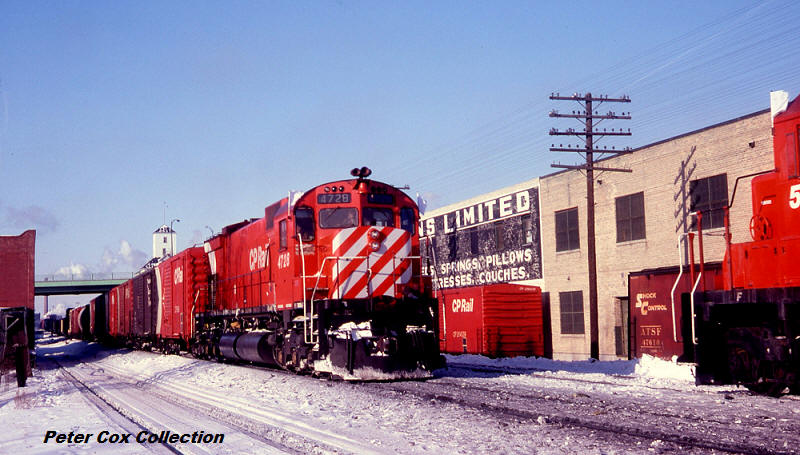
An Ariel view of the St-Luc Car Shop, and scenes from both ends inside the Diesel Shop and as it looked when new in the 1950’s. The interlocking panel shows South and North Junction and the CP Westmount Sub passing over the CP line to Lachine. (Bruce Chapman Collection).

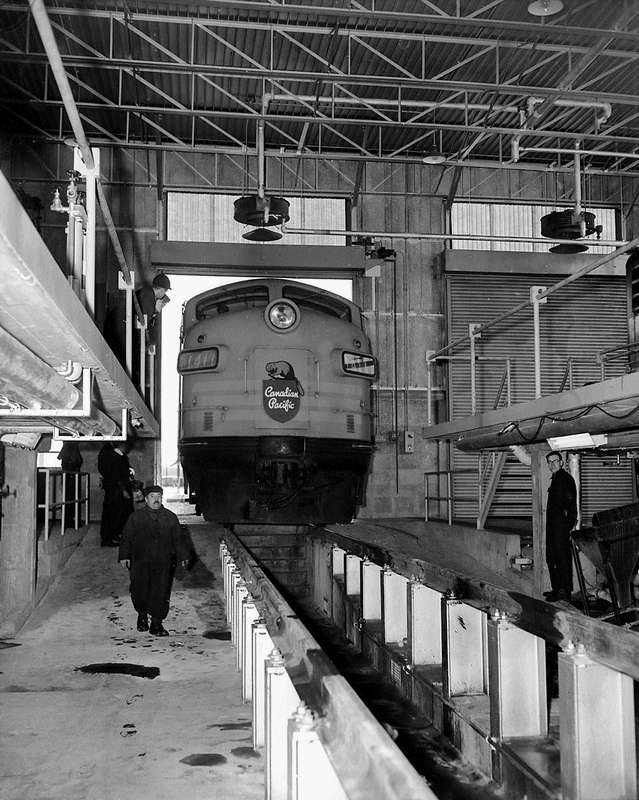
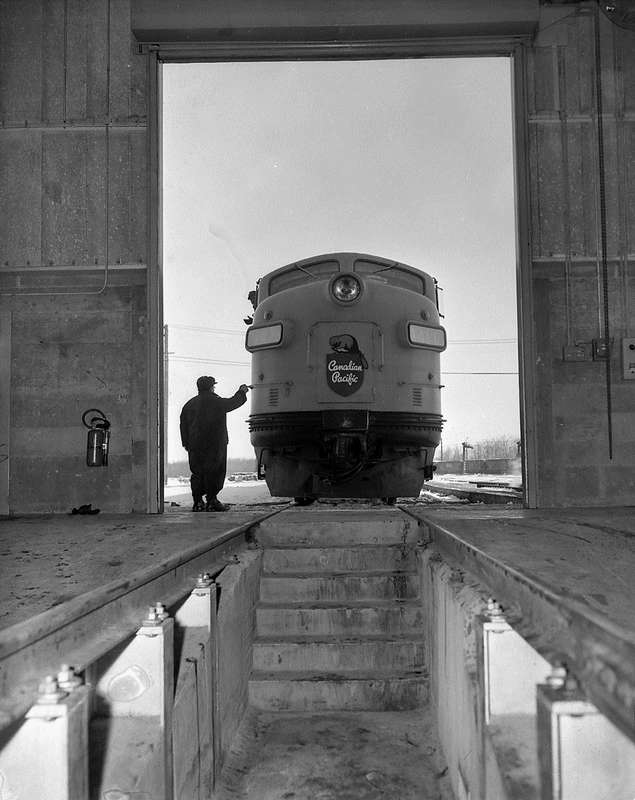
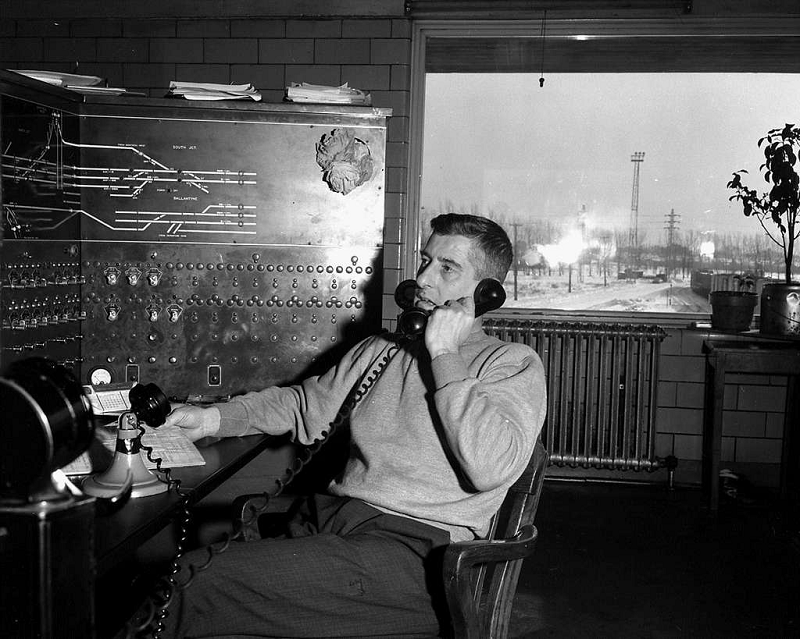

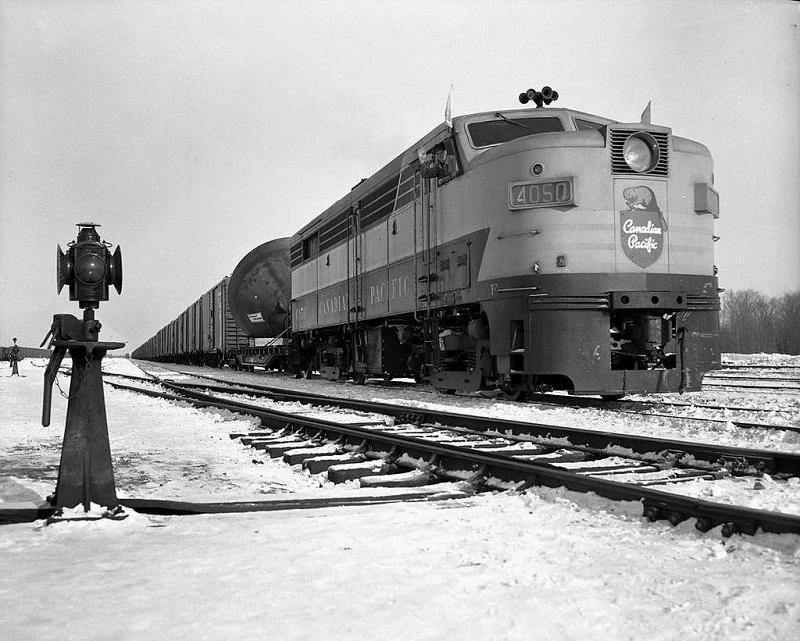
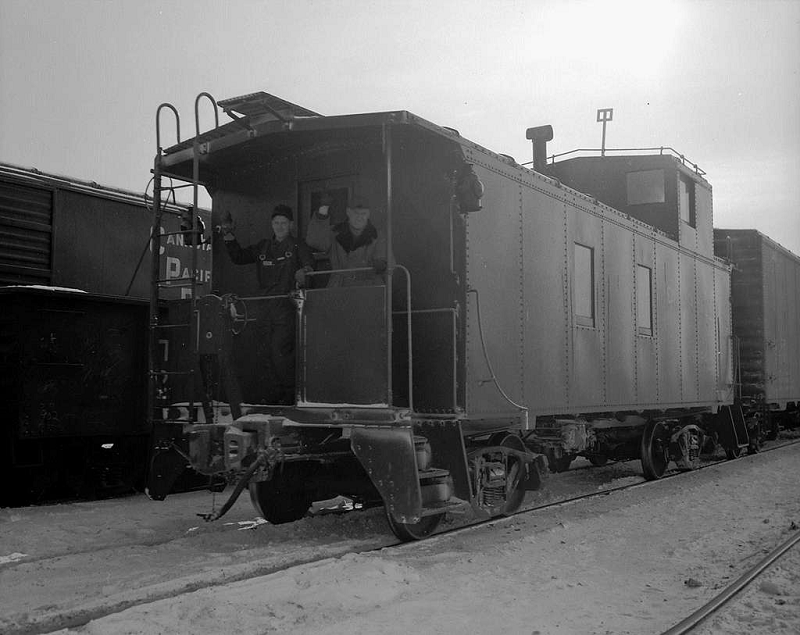
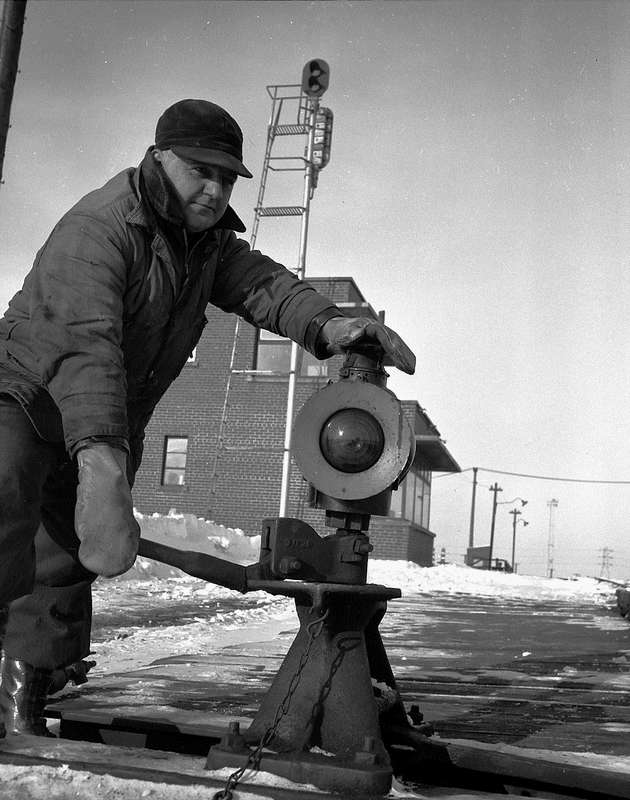
©CRO June 2013



